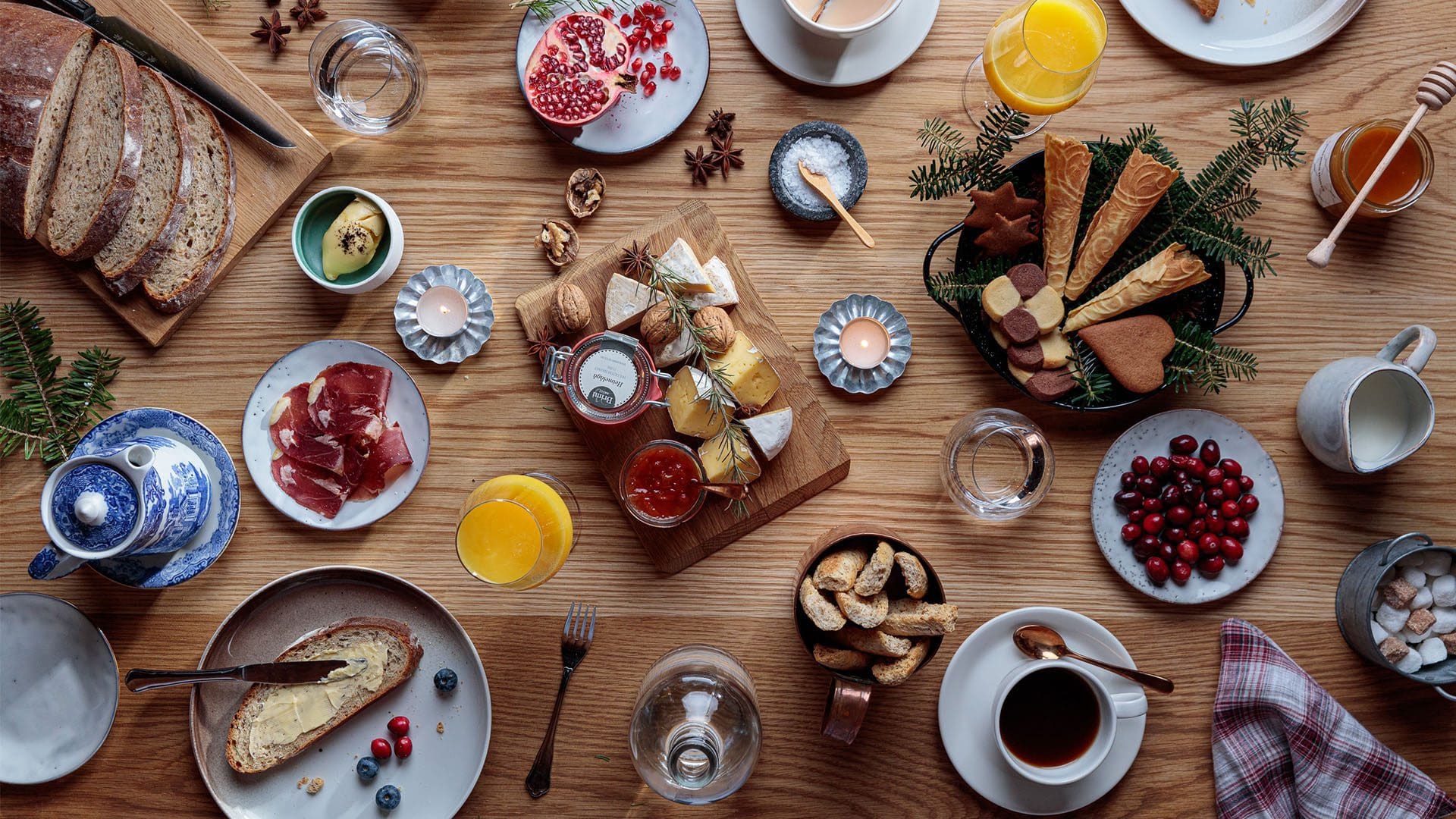
Five-star festive feast ideas from hotels around the world to make at home this holiday season
‘Tis the season to indulge, and indulgence do these recipes deliver. If you’re looking to impress your dinner party guests, here we spill the secret ingredients from the kitchens of boutique hotels which will be the talk of the table. From classics with a twist – and all the trimmings – to sweet treats you’ll want to save room for, you’ll find a generous helping of Christmas cooking inspiration below…
Starters & Nibbles
Spiced Cashews from Castle Hot Springs – USA

This Spiced Cashew recipe is the perfect snack to enjoy while relaxing around the fire, chatting with friends or curled up reading your favourite book.
Ingredients
- 1 egg white
- 1tbsp Togarashi
- 1tbsp Furi-Kaki
- 1/4 tsp salt
- 1tbsp agave syrup
- 2 cups cashews
Method
- Place egg white in large bowl and lightly whisk.
- Fold in the remaining ingredients and mix until well combined.
- Spread cashews on a baking sheet into an even layer.
- Toast in oven at 275f, stirring every 5 minutes until nice and golden brown (about 10 minutes total).
Squash Bisque from Castle Hot Springs – USA
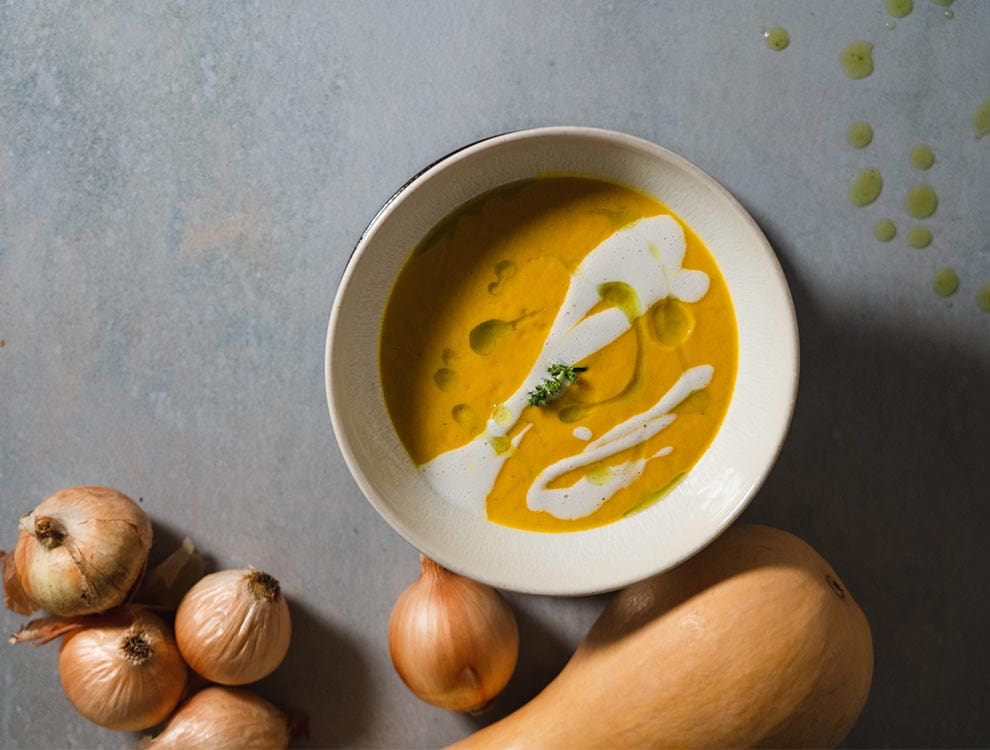
Ingredients
- 1 tbsp vegetable oil
- 2 winter squash, diced
- 5 carrots, diced
- 1 white onion, diced
- 2 garlic cloves
- 1 tsp sea salt
- 4 cups coconut milk
- 2 cups vegetable stock
- 1 tbsp Madras curry
Method
- In a large pot add oil, and begin to sweat your squash, carrots, onion, and garlic for 5 minutes, stirring frequently.
- Add salt, coconut milk, vegetable stock, and curry powder. Slow boil for an hour or until vegetables are fork-tender.
- Carefully transfer to a blender and blend to desired consistency. Pass through a chinois if a high-powered blender is unavailable.
- Serve hot, or chill and serve within 5 days.
Smoked Salmon on Toast from Pousada de Lisboa – Portugal
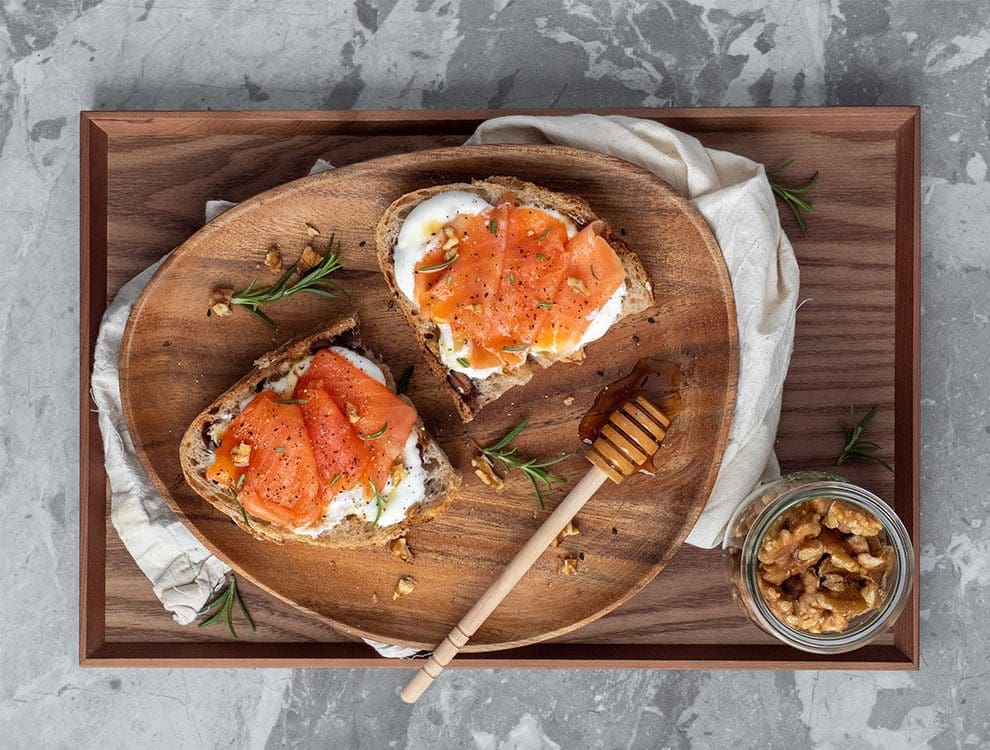
Ingredients
- 1kg fresh filet of salmon, sashimi grade
- 1kg fine salt
- 200g sugar
- 1 lime
- 30g radish
- 50g cream cheese
- 10g chives
- Black pepper
- 500g wood chips for smoking
- Cold smoker
Method
- Remove all the bones from the salmon fillet, add the salt and sugar and then cover the fillet on a tray with the skin down. Leave for 4 hours at room temperature and then 4 hours in the fridge.
- Remove salmon from the fridge, wash and leave in a tray with holes with the skin up overnight.
- The next day, keep the salmon in the same tray, smoke using woodchips under the tray for 4-5 hours in the cold smoker. R
- Remove the salmon from the cold smoker and let it rest in the fridge for at least 4 hours.
- Season the cream cheese with salt, pepper and chives, then serve on toasted bread.
Pumpkin Soup from The Margi – Greece
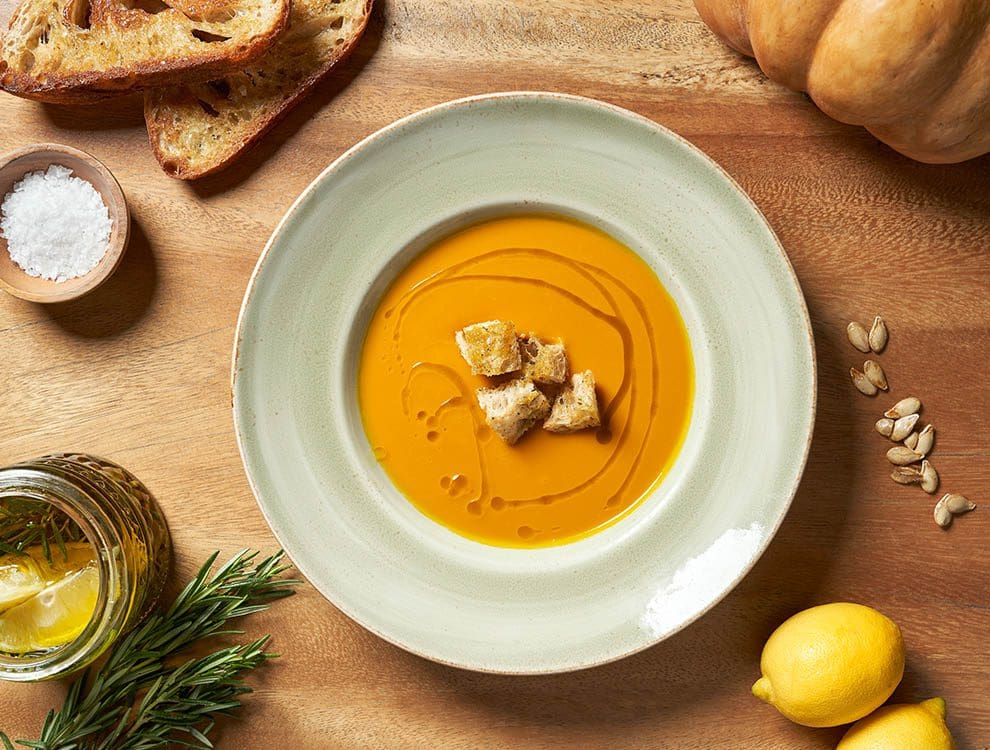
Ingredients
- 150g butter
- 20g semi-coarse salt
- 2kg pumpkin (cut in medium sized cubes)
- Pumpkin seeds for serving
Method
- In a low casserole melt the butter. Then add the pumpkin cubes and the salt. Mix it and cover it.
- On a low temperature, cook for 20-30 minutes. Once the pumpkin mixture is tender, remove the soup from heat and let it cool slightly. You can use an immersion blender to blend it in the pot for 5 minutes. We prefer to use a stand blender, which yields the creamiest results.
- Transfer the puréed soup to a serving bowl. Taste for seasoning, then serve scattered with croutons or drizzle with olive oil. You can also sprinkle with your remaining roasted pumpkin seeds.
Maple Bacon Eggnog Milk Tarts from The Marine – South Africa
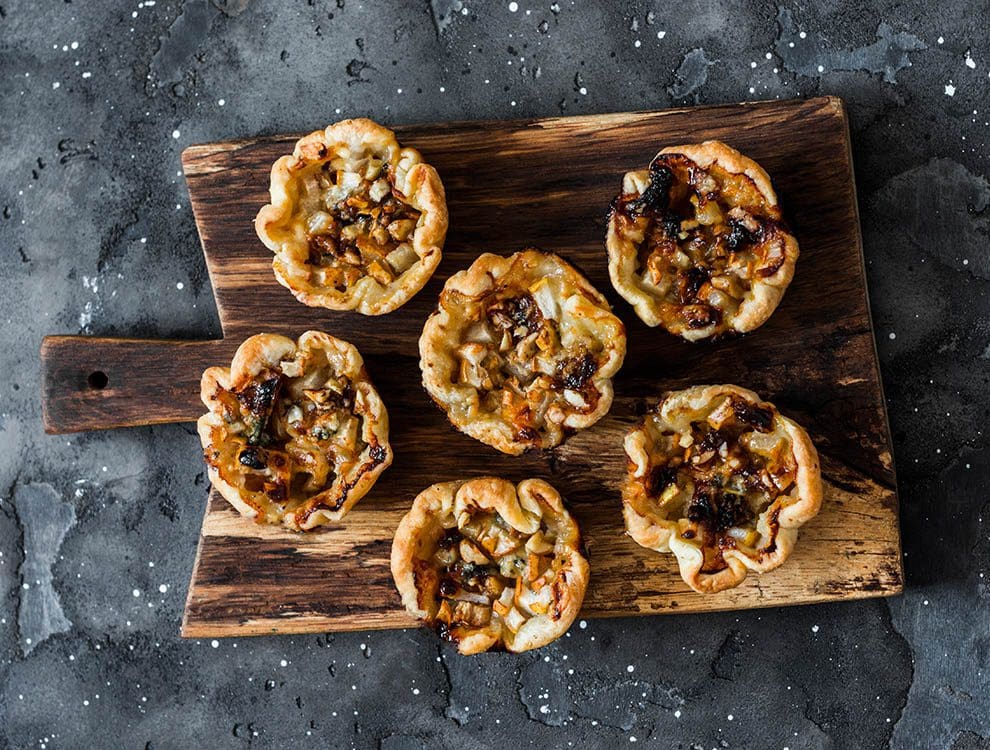
For the pastry
- 100g all purpose flour
- 20g icing sugar
- Pinch of salt
- 125g unsalted butter (cold, cut into small pieces)
- 1 large egg yolk
- Butter or spray the mini muffin tins– making sure it has been adequately sprayed. Set aside.
- Place flour, salt, and sugar in a food processor pulse for a couple of times to mix ingredients.
- Throw in butter and pulse until rough dough forms.
- Then add egg yolk – pulse until the dough barely comes.
- Remove dough and place on a work surface – knead just enough to incorporate all the dough, working the dough as little as possible. Do not overwork the dough, otherwise it will be too tough. When it’s ready, the dough will be barely moistened and come together into a ball.
- Divide the dough into portions, roll into balls, lightly press the dough into the prepare mini muffin tin moulds – working from the centre up until the bottom and sides are fully covered with pastry – again be very gentle when pressing the dough into the mini muffin tin moulds.
- Place the muffin tin in the freezer for at least 30 minutes or more. This helps prevent the dough from rising- if you are in a rush you can brick, then bake with beans to prevent rising.
- Preheat oven to 180 degrees and place the rack in the centre of the oven.
- Bake crust for about 5-7 minutes or until the crust is dry and golden browned. Set aside.
For the filling
- 2 slices streaky bacon
- 249ml full cream milk
- 20g butter
- 1 tbsp flour
- 13g cornflour
- 50g sugar
- 1 large egg
- 1 tsp vanilla extract
- 2 tsp Don Pappa Rum
- ½ tsp cinnamon for dusting
- Place saucepan over a medium heat, add bacon, sauté bacon until crisp, then add milk. Bring to a boil and remove from the heat, then let it stand for at least 10 minutes.
- In another bowl, mix flour, corn starch, sugar – whisk in eggs, vanilla, and rum until smooth. Gently whisk into the saucepan making sure there are no lumps.
- Now return the pan back on the stove, remove bacon – keep stirring constantly until in starts to bubble.
- Cook for about 5-6 minutes. Remove from heat and pour mixture into the baked pastry shell. Sprinkle with cinnamon. Chill until ready to be served.
Alpine Beetroot Cream Soup with Smoked Salmon Caviar & Pumpernickel from Kristiania Lech – Austria
Ingredients (serves 6)
- 1kg fresh beetroot
- 80g onions
- 3 garlic cloves
- 4 sprigs of thyme
- 50g butter
- 100ml cream
- 1L vegetable stock
- 2 bay leaves
- 2 slices of pumpernickel
- 200g smoked alpine salmon caviar
- Salt and pepper
Method
- Peel and finely dice the onion and 2 cloves of garlic. Peel the beetroot and cut into 2 – 3 cm cubes.
- Heat the butter in a large saucepan and sauté the onion and garlic until translucent over a medium temperature. Add the beetroot and sauté for about 5 minutes.
- Pour in the stock, add the bay leaves and the thyme sprigs and season with a little salt and freshly ground pepper.
- Let the soup simmer gently until the cubes of beetroot are soft (about 25 minutes).
- Meanwhile, chop the pumpernickel and toast it in a little olive oil. Keep soup plates warm.
- Remove the bay leaves and sprigs of thyme from the soup. Finely purée the soup with a hand blender or mixer and pass through a fine sieve. Add the cream and bring to the boil again. After about 5 minutes, season the soup with salt and pepper.
- Pour the soup into the preheated soup plates and spread a little cress on the edge of the plate with the caviar to finish off.
Truffled Steak Tartare from Huvafen Fushi Maldives – Maldives

For the pickled onion and mushroom
- 150g white wine vinegar
- 100g water
- 50g Madera wine
- 100g sugar
- 2g salt
- 10 pieces cardamom
- 10 pieces small onion
- 1 bunch brown enoki mushroom
Clean and cut the onions and the mushrooms. Cook all the ingredients together in one pot until the sugar mixes perfectly, then add the onions, and cook for 1 minute. Remove from the heat, put in a jar, then add the mushrooms and rest for 24 hours.
For the dry egg yolk
- 4 egg yolks
- 130g salt
- 100g sugar
Mix the sugar and the salt. Use a small container and cover the yolks and rest in the fridge for 48 hours. Clean with water and dry then cook in the oven at 60 degrees for 8 hours.
For the truffle emulsion
- 10g lime juice
- 10g Dijon mustard
- 2g salt
- 2 egg yolks
- 30g rice vinegar
- Vegetable oil
- 30g truffle sauce
Mix the ingredients in a blender, then slowly add the oil to create an emulsion.
For the steak tartare
- 160g M5 tenderloin
- 10g shallots
- 10g pickles
- 10g capers
- 1 egg yolk
- 4g Worcester sauce
- 6 mushrooms
- 10g butter
- Salt and pepper
Cut the steak into small squares, then do the same with the shallots, pickles and capers. Sauté the mushrooms in butter and set aside. Mix the steak with shallots, pickles, capers. Then add the yolk and the sauces.
To serve
Using a ring, plate the tartare then add the pickled onion and mushroom on top. Make bonbons with the truffle emulsion and place the cured egg yolk on top. Drizzle with some olive oil to finish.
Noix de Saint-Jacques rôties (roasted scallops), “celerisotto” with black truffle and grilled corn coulis from Hôtel San Régis – France
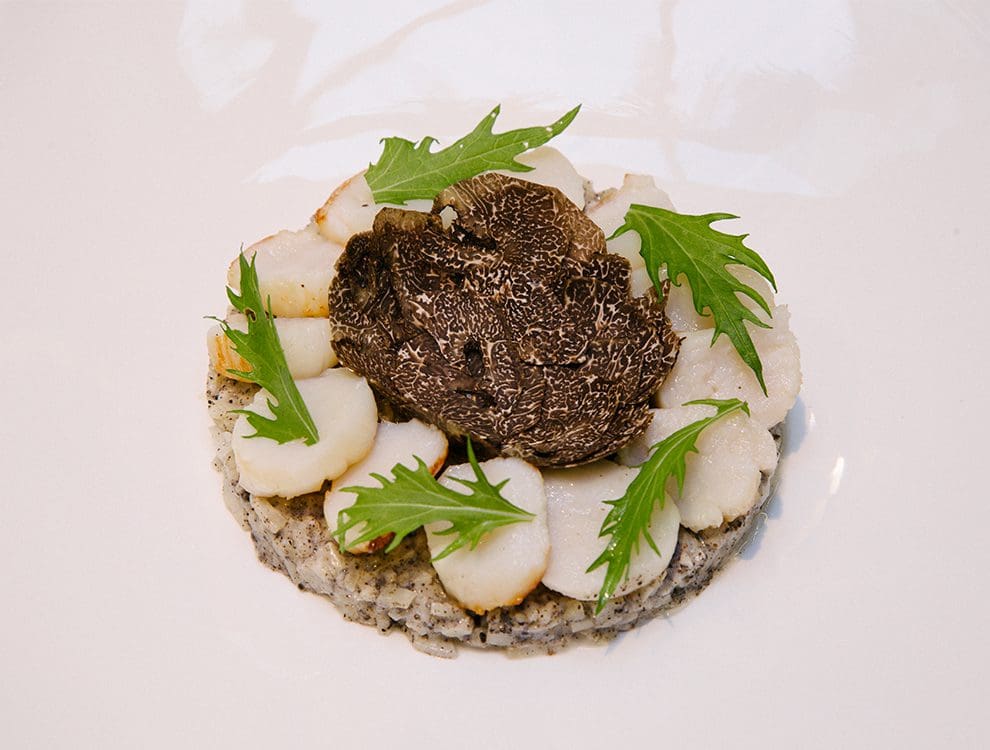
Ingredients (serves 4)
- 16 pieces of scallops
- 1 celeriac
- 1 black truffle (20g)
- 1 ear of corn
- 50g butter
- 80g heavy ream
- 1 lemon
Method
- Remove the shells from the scallops or ask your fishmonger to do so. Rinse the scallops under cold water and place them in a cool place on absorbent paper.
- Peel the celery and cut into brunoise (small cubes). For the brunoise, start by cutting thin slices, then sticks and finally small cubes. Set aside in water with a lemon cut in half to keep the celery white.
- Cook the corn on the cob in vegetable broth for 40 minutes. Once cooked (when the kernels are tender), remove the husks and blend with 40g of cream to make a smooth coulis.
- Clean and brush the truffle, peel it and chop the skin. Set aside the whole truffle for shavings and the chopped truffle for the celery.
- Cook the cubes of celeriac (previously drained) in a saucepan with a little butter. Sweat it like rice, add a little pepper, then add the chopped truffle off the heat.
- Arrange the truffled celery in the centre of the plate.
- Cook the scallops in a very hot pan with 15g of butter, salter with fine salt on the side that will be placed first in the pan to have a beautiful caramelised colour.
- Cook for 2 minutes over medium heat, turn them over and take the pan off the heat so that they finish cooking for another 30 seconds.
- Arrange 4 nuts per person, pour the corn coulis on top – et voilà!
Red Turnip Linguine with Amberjack, Caviar & Burrata from Hotel Vilòn – Italy

Ingredients
- 320g linguine
- 50g smoked amberjack
- 1kg mussels
- 10g caviar
- 100g burrata
- 30g milk
- 500g cooked beetroot
Method
- For the turnip extract – use a centrifuge, obtain the turnip extract, recover the solid part and dry it at 50 degrees.
- Clean the mussels, and make them open in a pot with a little extra virgin olive oil and 1 clove of garlic. Add a ladle of water. Once cooked, recover all the cooking liquid, taking care to filter it with a sieve and a napkin.
- For the burrata sauce, blend the burrata with the milk to make a velvety sauce.
- Cook the linguine in plenty of water, drain very “al dente” and finish cooking in the pan, adding a little bit of the cooking water from the mussels.
- Also add the beetroot extract and finish cooking the pasta. Serve the pasta and, using a spoon to help, decorate with the burrata sauce, caviar and a few slices of smoked amberjack.
Main Courses & Sides
Stuffed Christmas Duck from DasPosthotel – Austria
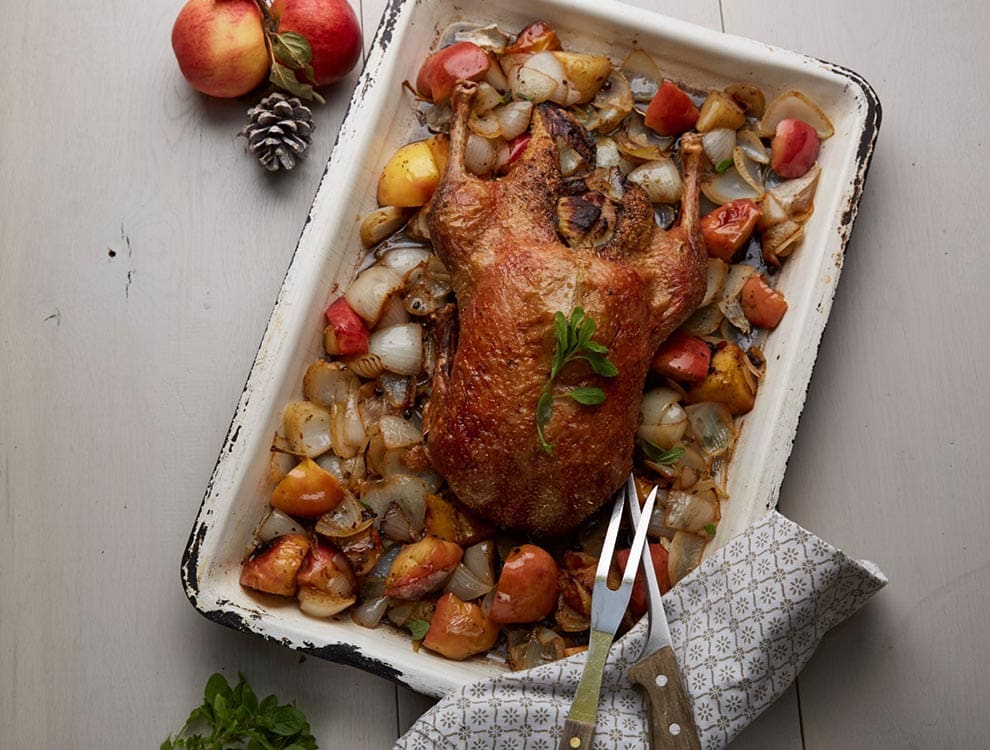
Ingredients (serves 4)
- 1 ready-to-cook organic duck from your trusted butcher
- 2-3 onions
- 2 apples
- Oregano
- Salt
- Pepper
Method
- For the filling, chop the onions and apples and mix with some oregano.
- Rub the inside of the duck with salt and pepper and fill with the onion and apple mixture.
- Place the stuffed duck in a roasting tin and cook for 1 hour in a pre-heated oven at 160 degrees.
- To make the skin nice and crispy, brown it for another 15 minutes at 180 degrees. Open the oven and let the duck rest for a while.
Top tip: A metal bowl with water in the oven makes duck juicier.
Pancetta Brussels Sprouts in a Creamed Garlic Sauce from Homewood – England
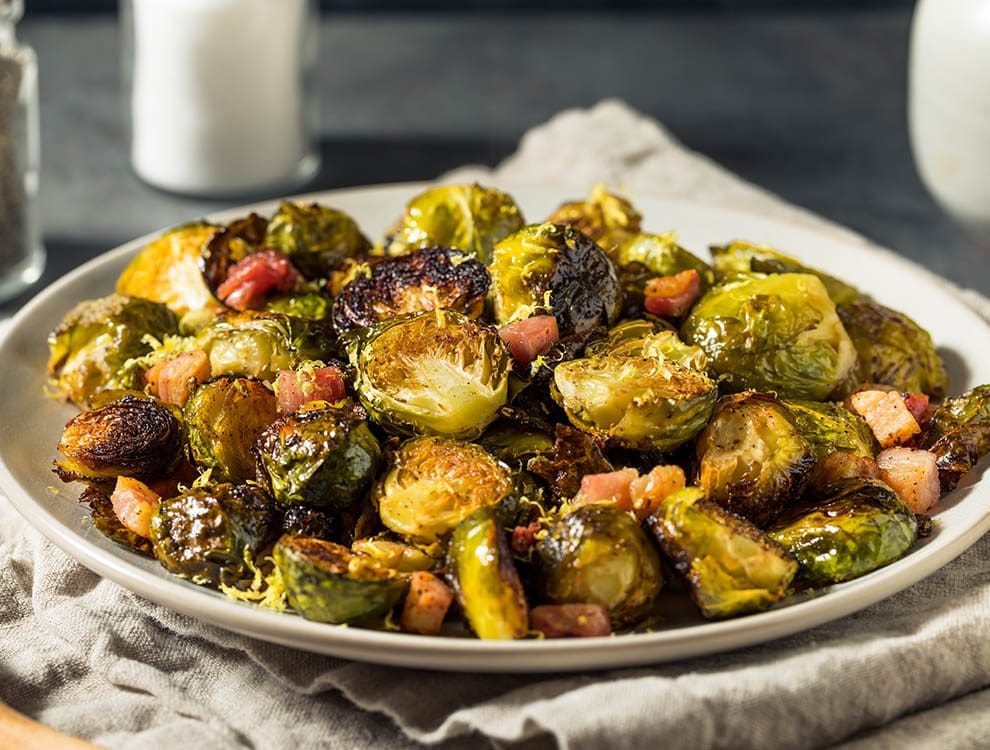
Ingredients
- Brussels sprouts
- 1/4 bunch thyme
- 8 shallots
- 2 garlic cloves
- 1 box pancetta lardons
- 1 bottle double cream
- 600ml white wine
- 50ml lemon juice
- 5 tsp ground nutmeg
- Salt and pepper
Method
- Fry pancetta over a high heat until nice and browned.
- Lower the temperature, then sweat in the shallots and thyme.
- Deglaze with white wine and reduce by 70% before adding the lemon.
- Add cream and reduce further, then add the nutmeg.
- Brussels (whole) – blanch 2 ½ minutes then ice bath.
- Brussels (sliced) – blanch 1 minute the ice bath.
- Finish with pancetta and pangrattato (garlic bread crumbs).
Roast Turkey Bagel with Onions & Nuts from Hotel Infante Sagres – Portugal
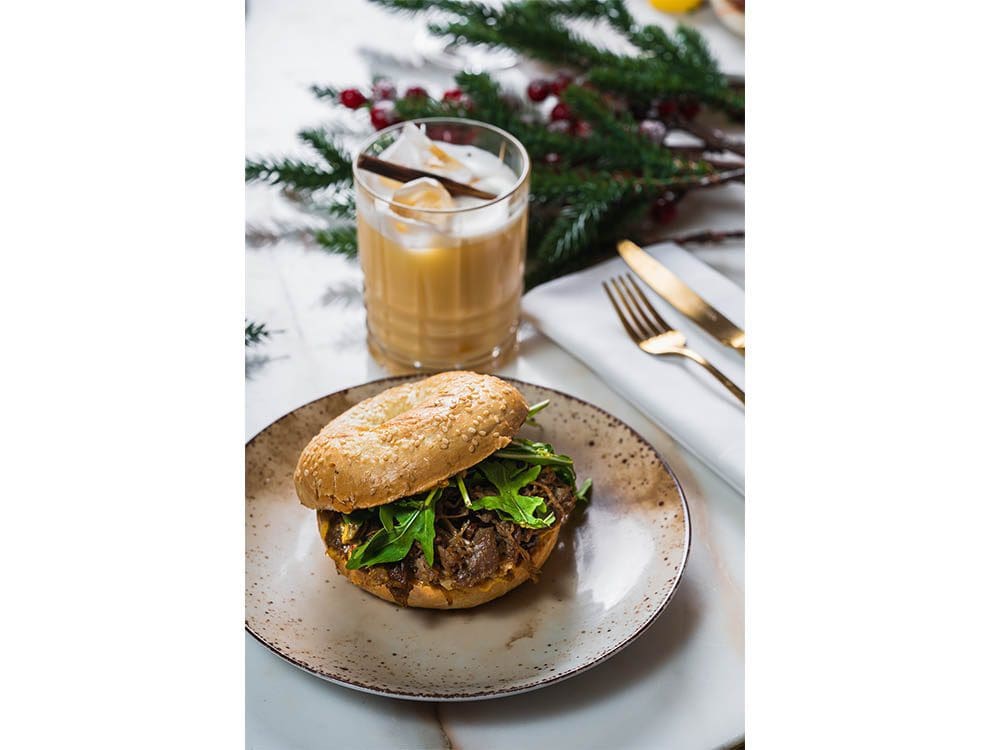
Ingredients (serves 4)
- 1 small turkey leg
- 10g thyme
- 10g rosemary
- 30ml olive oil
- 10g salt
- 5g pepper
- 50g lard
- 200g onions
- 300g carrots
- 300g leeks
- 8g sweet peppers
- 25g dried garlic
- 300ml red wine
- 150g poultry liver
- 40ml Madeira wine
- 15g unsalted butter
- 30g sultanas
- 30g walnut kernels
- 30g almonds (without skin)
- 40g dried figs
- 40g dried apricots
- 20g chive
- 30g pickles
- 80g rocket
- 4 bagels
- 30g mayonnaise
Method
- Marinate the leg with thyme, rosemary, lard, sweet paprika, red wine, salt, pepper and olive oil.
- Peel the carrot and cut into small pieces, together with the leek, crush the dried garlic cloves and add to the marinade. Set aside for at least 24 hours in the fridge.
- Preheat the oven to 165 degrees and roast the turkey leg along with the marinade for 1 hour, turning sides every 20 minutes.
- Coarsely chop 1 onion and sauté in butter. When browned, add the poultry livers and season with salt and pepper. Leave to caramelise and flambé with the wine.
- In a food processor, grind the prepared livers with all the dried fruit until it turns into paste.
- Shred the turkey and fold in the liver and nut paste.
- Toast the bagels in a toaster, spread a little mayonnaise on each side, place the hot turkey mixture and the rocket.
- Garnish with onion and chopped pickles.
Beef Wellington from The Atlantic Hotel – Jersey
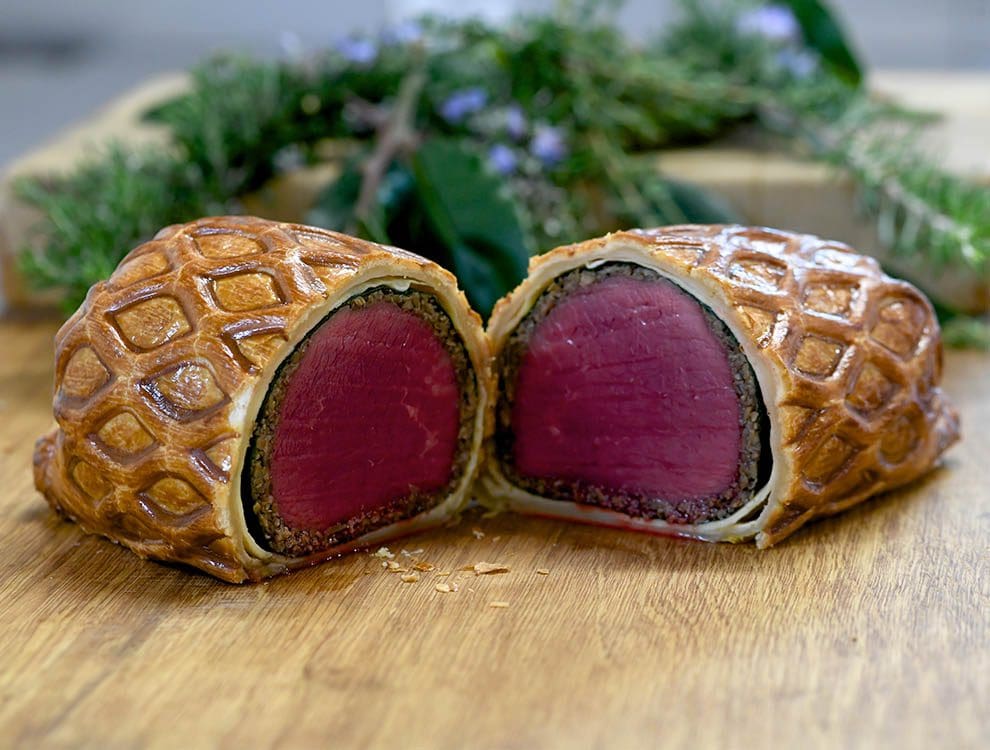
The duxelles, spinach sheets and crepes can be prepared well in advance, while the Wellington can be made up to 24 hours in advance and kept in the fridge.
For the mushroom duxelles
- 50ml olive oil
- 2 garlic cloves
- 2 banana shallots
- 750g button mushrooms
- Truffle oil
Roughly chop the garlic, shallots and mushrooms and sweat in the olive oil over a high heat until all the moisture has evaporated and the pan is completely dry. Transfer to a food processor and pulse until a coarse purée is achieved. Return to the pan and return to the heat and continue to cook until the pan is once again dry. Season to taste with sea salt, freshly milled black pepper and truffle oil.
For the spinach sheets
- 18 large leaf spinach sheets
Remove the stalks from the spinach and blanch in boiling water for a few seconds before plunging into iced water. Remove the spinach leaves from the water and dry flat on absorbent kitchen paper.
For the crepes
- 1 egg
- 25g plain flour
- 50ml milk
- 15ml water
- Olive oil
Whisk all the ingredients together in a mixing bowl. Pre-heat a large non stick frying pan. Wipe a small amount of oil on the pan before adding enough batter to produce a wafer-thin crepe. Cook for 30 seconds on each side before removing from the pan and repeating the process until all the batter is used.
For the beef
- 500g centre cut beef fillet (125g per portion)
Season the beef fillet with freshly milled black pepper (no salt).
For the puff pastry
- 2 sheets of all butter puff pastry
- 3 egg yolks
To build the Wellington
- Cover the work surface with cling-film.
- Lay the spinach leaves together on the cling-film to form one large sheet.
- Spread an even layer of duxelles over the spinach sheet.
- Place the beef fillet at the front end of the spinach and duxelles sheet.
- Using the cling-film to help, roll the beef fillet in the spinach and duxelles so it is completely encased – it should be as tight as possible.
- Cover the work surface with cling-film again. Lay the crepes on the cling-film.
- Remove the beef, spinach and duxelles roll from the cling-film and place at the front end of the crepe.
- Using the cling-film to help, roll everything in the crepe so it is completely encased – it should be as tight as possible.
- Lay a sheet of puff pastry on the work surfac. Using a pastry brush, egg wash the pastry.
- Remove the cling-film from the rolled crepe, spinach, duxelles and beef.
- Place on the puff pastry sheet and roll until completely encased in a single layer of pastry. Tightly close the ends.
- Transfer to a greaseproof paper lined baking tray. Egg wash the pastry wrapped Wellington.
- Use a lattice cutter roller on the remaining sheet of puff pastry.
- Lay the lattice over the Wellington, and egg wash.
To cook the Wellington
- Leave the Wellington at room temperature for a minimum of 1 hour before cooking.
- Pre-heat your oven to 200 degrees fan.
- Place the beef Wellington in the oven for 20 minutes. After the 20 minutes cooking time and depending how you would like your beef cooked, complete the following:
- Rare/medium rare – remove from the oven.
- Medium – reduce your oven temperature to 160 degrees fan and cook for an additional 5 minutes.
- Medium/well – reduce your oven temperature to 160 degrees fan and cook for an additional 10 minutes.
- Well done – reduce your oven temperature to 160 degrees fan and cook for an additional 20 minutes.
4. Once you have removed your Wellington from the oven, allow to rest at room temperature (uncovered) for a minimum of 40 minutes.
5. Before serving place the Wellington back in the oven at 180 degrees fan for 5 minutes, then serve.
Oven-baked Turkey Breast with Sweet Potato from D-Resort Göcek – Turkey
For the turkey
- 300g turkey breast
- 50g carrots
- 50g mushrooms
- 50g onions
- 5g garlic
- 4g fresh thyme
- 30g celery
- 30g leek
- 5g salt
- 5g black pepper
- 5g sweet paprika powder
- 30g butter
- 50ml olive oil
Marinate the turkey in salt, black pepper, red pepper and fresh thyme. Chop the carrots, celery, leek, onion, garlic and mushrooms and place them on the oven tray. Place the marinated turkey breast meat on top of the vegetables, and cover with foil paper. Cook in a preheated 190 degree oven for 40 minutes.
For the jus sauce
Cook the turkey bones with the vegetables and the juice of the vegetables over a low heat until it has a slightly liquid consistency.
For the sweet potato
- 100g sweet potatoes
- 30g teriyaki sauce
- 3g roasted sesame
- 3g chives
Cut 50g rings of the sweet potato and cook in a steam oven at 130 degrees for 2 hours. To serve, heat the sweet potato rings over the grill and top with teriyaki, sesame, and chives.
“For Cod’s Sake” from Lumiares Hotel and Spa – Portugal

Ingredients (serves 4-6)
- 800g codfish fillet
- 100g purple onion
- 3 garlic cloves
- Bay leaves
- 500g dry chickpeas
- 50g shallots
- 20g garlic to roast
- 150ml Portuguese olive oil
- Sprig of thyme
- 300g Hokkaido pumpkin
- 10 quail eggs
- 100g cornbread
- 50g black olives
- 1/2 tsp Portuguese fig vinegar
- 200g kale
- 1 lemon
- Salt to taste
- Algarve Fleur de Sel
Method
- Soak the chickpeas in water for about 24 hours. Then, cook them in new water along with the shallots, crushed garlic, thyme and bay leaves.
- Add salt and let it cool for about 20 minutes. Set a third of the chickpeas portion aside for plating. Blend the rest with the cooking water and olive oil to make a chickpea purée.
- Wash the kale and remove the stems. You can do this by simply passing the leaves through your fingers. Season with lemon juice and salt and squeeze the leaves. Drain the water and place the kale leaves in the oven at 90ºC (194ºF) until they’re crispy.
- Cut the onion(s) into slices and season with vinegar, olive oil and fleur de sel. Place in the oven and roast at 180ºC (356ºF) for 4 minutes.
- Cut off the top of the garlic head, cover with foil and bake at 140ºC (284ºF) for about 40 minutes until the garlic gets a caramel colour. Squeeze the heads to remove the roasted garlic, season with salt and pepper and mix with olive oil.
- Cut the pumpkin in half and remove the seeds. Cut in slices, season with thyme, olive oil, garlic, and salt. Roast at 160ºC (320ºC) for approximately 15 minutes.
- Cook the quail eggs in boiling water for 2 1/2 minutes, then cool in water with ice. When plating, slightly nick the top of the eggs just enough so you can see the egg yolk.
- Grind the cornbread with the unpitted olive and season with salt and pepper.
- Remove the skin and the bones from the codfish, top it with the cornbread preparation and bake at 160ºC (320ºF) for 5-6 minutes.
- Finally, time to plate all this delicious food and enjoy.
Kambing Bakor Kecap from Viceroy Bali – Indonesia
For the lamb rack
- Lamb rack (with 2 bones)
- 70g sweet soy coriander glaze
- Tejakula salt and ground black pepper
- In a large bowl, add the lamb rack, and season generously with the Tejakula salt. Pour on the sweet soy coriander glaze, marinate over the meat, and turn a few times to coat.
- Cover with cling-film and refrigerate for at least 3 hours. When the lamb is resting, preheat a grill pan to medium-high heat. Set the rack meat side down over the hottest part and cook until evenly brown.
- Turn the rack and continue cooking directly over the heat until browned, approximately 5 more minutes. Transfer the rack to the cooler side, cover with a large heatproof bowl, and continue cooking, turning once more, until the internal temperature reaches 130°F (for medium-rare, this takes approximately 15 minutes).
- Transfer the lamb to a plate, and set aside to rest for 10 minutes (the lamb will continue cooking as it rests).
For the semi-dried Bedugul tomato
- 250g Bedugul tomato
- 5g garlic
- 0.5g thyme
- 2g Tejakula salt
- Pinch of ground black pepper
- Cut tomatoes in half lengthwise. Cut out the core and remove the skin. Arrange the halved tomatoes over a baking sheet lined with parchment paper.
- Brush lightly with olive oil. Sprinkle with tejakula salt, ground black pepper, slice of garlic and chopped thyme.
- Preheat the oven. Bake for 2 hours at 135 degrees if using a fan-oven, until semi-dried. Chop the semi dried tomato until all blended with garlic and thyme.
- Cool at room temperature until ready to serve.
For the fried cauliflower couscous
- 90g cauliflower floret
- 20g sugar
- 250ml canola oil
- Olive oil
- Fine salt
- Cut the cauliflower into medium-sized florets, wash, and dry completely.
- Fill about 250ml of a pot with canola oil, just enough to submerge the cauliflower in. Heat up the oil, toasting with sugar before frying.
- Drop a couple of florets at a time into the hot oil, stirring frequently until they turn golden-brown for approximately 2-5 minutes.
- Once golden, immediately take them out of the oil and place them on a paper towel to absorb excess oil. Finely chop the fried cauliflower floret to achieve the size and texture of couscous. Season with olive oil and fine salt. Keep aside until ready to use.
For the coconut rice cake
- 90g rice
- 100ml coconut milk
- Water
- Salam leaf, lemongrass, kefir lime leaves
- Fine salt and white pepper
- Wash and drain the rice, place in a rice cooker combined with water, coconut milk, salam leaf, lemongrass, kefir lime leaves and season with salt and pepper.
- Stir well and cook on regular white rice setting. After the rice is done, transfer cooked coconut rice to wrap and roll into a cylinder shape.
- Pan sear the coconut rice with oil until golden in colour, set aside and check the inside is hot – serve immediately.
For the sweet soy coriander glaze
- 90g sweet soy sauce
- 15g honey
- 15g peanuts
- 5g candlenuts
- 3g bird eye chilli
- 10g shallots
- 5g garlic
- 5g coriander seeds
- 10ml Kalamansi rice
- Fine salt
- Black pepper
- Sear the candlenuts and coriander seeds without oil until golden brown.
- Meanwhile, fry the shallots, garlic, bird eye chilli, and peanuts until cooked and tender.
- Blend all the ingrdaients until smooth and combine with sweet soy sauce, honey and kalamansi juice.
- Season with salt and black pepper. Keep the glaze at room temperature.
For the Indonesian pickled acar
- 30g cucumber
- 30g carrots
- 9g shallots
- 220ml water
- 110g sugar
- 110g rice vinegar
- 3g Tejakula salt
- Peel the cucumber, and cut it into square cubes.
- Peel the baby carrot until clean and keep the carrot stem.
- Peel away the top layer of the shallot and the skin. The pickling liquid starts from boiled water, sugar, salt, and rice vinegar in a pot until the sugar dissolves.
- Turn off the heat and add all the vegetables into the pot. After 20 minutes of resting, transfer the pickle to clean glass jars and vacuum the vegetables until the pickling liquid has been absorbed.
- Char the carrot with a blowtorch. Keep in the fridge until serving.
To finish
- Place a piece of grilled lamb on a plate and arrange the baby carrot and Italian parsley on the top of the lamb bone.
- Place the coconut rice cake beside the lamb, cover with semi-dried tomato, garnish with nasturtium and peperomia.
- Mold the fried cauliflower couscous with a ring cutter. Place the cucumber, shallots, red radish, and fennel leaf.
- Finish the plate with lamb sauce. Serve hot.
Venison Loin with Beetroot, Chestnut & Red Berries from The Sukhothai Shanghai – China
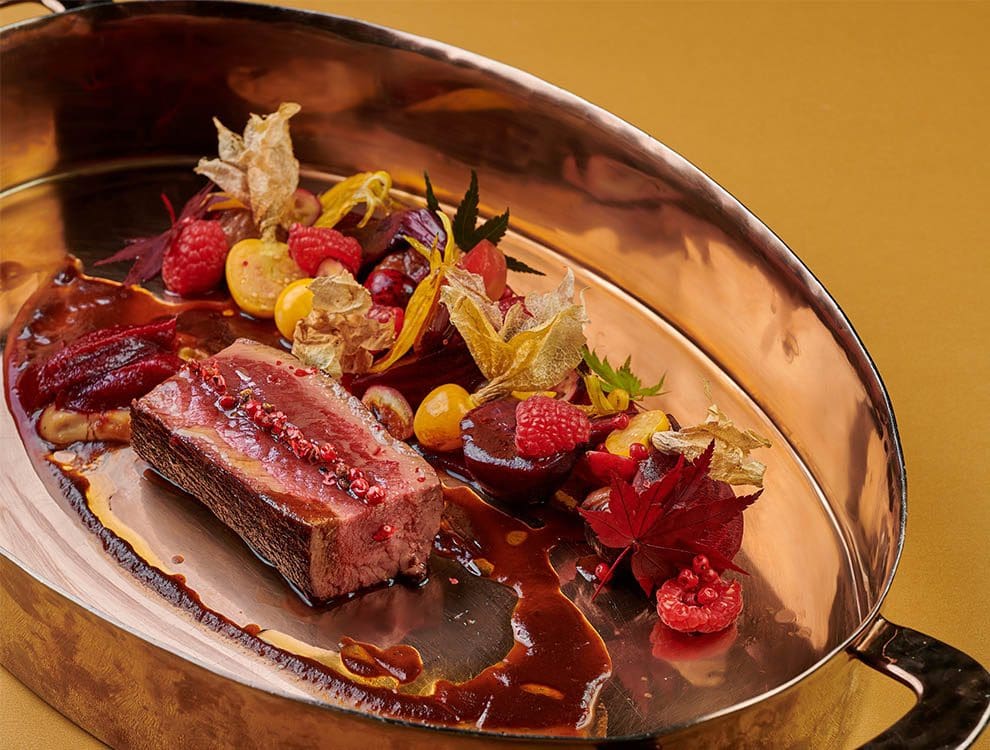
Ingredients
- 180g venison loin
- 80g red baby beetroots
- 80g yellow baby beetroots
- 60g beetroot purée (see below)
- 40g fresh cranberries
- 60g chestnut
- 80g chestnut purée (see below)
- 50g venison jus
- 40g raspberries
- 10g olive oil
- 1g salt
- 1g black pepper
- Pinch of pink pepper
- 5g thyme
- 4g juniper
- 10g butter
- 2 garlic cloves
For the beetroot purée
- 1kg beetroots
- 100g extra virgin olive oil
Preheat the oven to 180 degrees. Wash the beetroots and arrange them on the plate, cover with foil and bake in the oven for 2 hours. When cooked, peel the beetroot and mix in the pulp.
For the chestnut purée
- 500g chestnut
- 50g butter
- 200g vegetable stock
- 150ml cognac
- 1g salt
- 1g pepper
- 1g rosemary
Heat extra virgin olive oil in a saucepan, add the shelled chestnuts, and brown until golden. Add the butter and rosemary, let the butter froth. Add the salt and pepper and deglaze with the cognac. Add the vegetable broth and cook for 15 minutes over a low heat. Mix everything and pass it through a thin strainer.
Method
- Season the venison with salt and pepper and start searing it evenly on all sides. Heat a pan over low heat, add oil.
- When the venison is golden brown, add the butter, thyme, rosemary, garlic and juniper berries.
- Cook the venison, being careful not to burn the butter. When the venison reaches a temperature of 55 degrees in the centre, set it aside to rest.
- Heat a pot with extra virgin olive oil and thyme, add the beetroots, salt, pepper and a little vegetable broth. Always add small quantities of broth to avoid burning them. When they are cooked, put them aside.
- Heat extra virgin olive oil in a saucepan, add the shelled chestnuts and brown until golden. Add the butter and rosemary, let the butter froth. Add the salt and pepper and deglaze with cognac. Add the vegetable broth and cook for 15 minutes over low heat, then put aside.
- Arrange the beetroot purée and chestnut purée on a plate and gently place the vegetables on top, garnish with the berries. Cut the venison in half and add to the place, then finish with venison jus, sea salt and pink pepper.
Christmas Turkey with Cranberry Sauce from Velassaru Maldives – Maldives
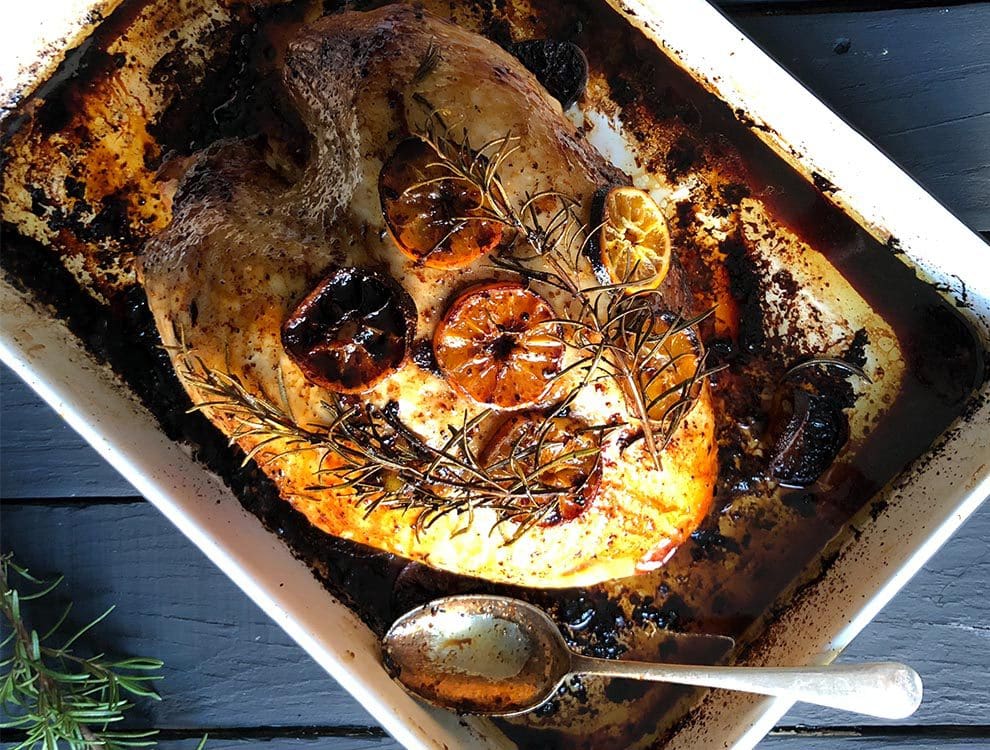
For the turkey
- 4kg whole turkey, neck and giblets
- 150g butter, softened
- 2 oranges, zested and halved
- Bunch of rosemary leaves picked and chopped, stalks reserved
- 1 large onion, unpeeled, roughly chopped 4 star anise
- 30g cardamom
- 3 cinnamon sticks
- 2 carrots, roughly chopped
- 150g smooth orange marmalade, warmed
- Place the turkey in a large roasting tin, breast-side up, and gently push your fingers under the skin until you can fit your whole hand down the length. Season the turkey all over with 1 tbsp sea salt flakes. Cover and chill for at least 1 hour, or up to 24 hours.
- Remove the turkey from the fridge 1 hour before cooking so it can come to room temperature. Beat the butter, orange zest, star anise, cardamom and half the rosemary leaves with some pepper.
- Transfer the turkey to a board and put the onions, carrots and turkey neck and giblets into the tin. Sit the turkey on top, then spread about 4 tbsp of the flavoured butter under the skin, over the breasts, using your hands. Spread the rest of the butter over the outside of the turkey, ensuring the legs and wings are well coated. Put the orange halves and rosemary stalks in the cavity.
- Heat the oven to 180C/160C fan/gas 4. Work out the cooking time based on 40 minutes per kg. A turkey this size will need about 2 hours 40 minutes, plus 30-45 minutes resting. Cover the turkey loosely with foil and roast for 2 hours.
- Remove the foil and brush generously with some of the marmalade, then roast for 15 minutes more. Brush with more marmalade and sprinkle with the remaining rosemary leaves. Return to the oven for a final 15 minutes.
- Check the turkey is cooked through by inserting a meat thermometre into the thickest part of the breast – it should read 65 degrees, and the thickest part of the thigh should read 75 degrees. If the turkey isn’t up to temperature, return to the oven for 15 minutes at a time until it’s cooked through.
- Leave the turkey in the tin for 10 minutes, then lift onto a lipped board or tray to rest, uncovered, for between 20-40 minutes.
- To make the gravy, skim all but about 2 tbsp fat off the juices in the tin. If the roasting tin is flameproof, put it directly over a medium heat. If not, tip the juices into a large shallow pan first. Scatter over the flour and stir to make a paste, then stir in the wine and bubble for 2 minutes.
- Pour in the stock and bring to a simmer, then add some soy sauce and simmer for 10 minutes until the gravy has thickened. Add any resting juices from the turkey to the gravy, season to taste, then strain into a jug. Carve the turkey and serve with the gravy on the side.
For the cranberry sauce
- 100g dried sweetened cranberries
- 1 orange zest finely grated, juiced
- 100g redcurrant jelly
- 125ml water
Place the cranberries in a bowl, cover with hot water and set aside for 30 minutes. Drain the cranberries, put in a saucepan with the remaining ingredients and simmer over low heat for 10 minutes. Set aside to cool.
Veal Tenderloin with Celery & Ginger Purée from Hotel Casa Palmela – Portugal
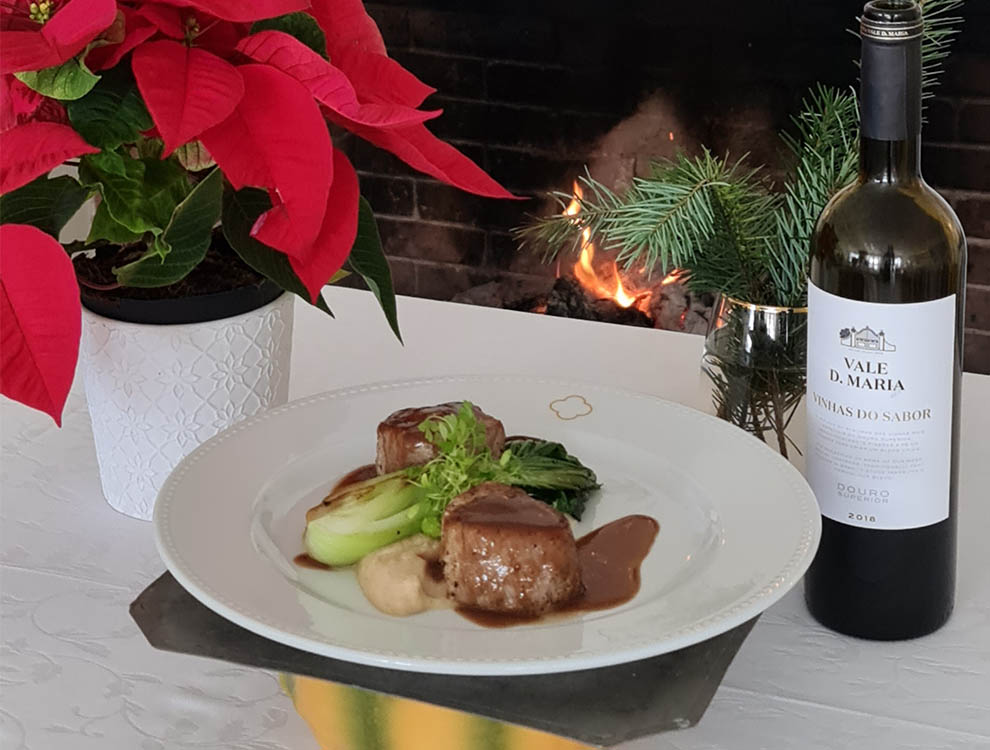
Ingredients
- 180g veal tenderloin
- 100g celery
- 3g ginger
- 1g coriander seeds
- 2g salt
- 2g black pepper
- 100ml milk
- 50g butter
- 5g nutmeg
- 5g pecan nuts
- 200ml meat broth
- 100ml port wine
- 20g figs
- 2g pink pepper
- 20g mini pak choi
- 1 garlic clove
- 1g thyme
- 100ml olive oil
- 6g demerara sugar
- 100ml vegetable broth
Method
- Cook celery in milk and butter with ginger and coriander seeds.
- Drain and season with salt, pepper and nutmeg and mash and crunch to get a creamy purée.
- Season the veal loin with salt and pepper, store in a vacuum bag with garlic and thyme. Leave to marinate for 24 hours.
- Cook in sous-vide at 53 degrees for 45 minutes.
- Remove from bag and sauté with oil.
- Caramelise the walnuts with demerara sugar and butter.
- Seal the sautéed pak choi and sprinkle with vegetable broth.
- Sauté figs, refresh with port wine, add meat broth and let it reduce to a creamy point.
Desserts
Snowman Pannacotta with White Chocolate, Yuzu & Rosemary from Vista Palazzo Lago di Como – Italy

Ingredients
- 200g white chocolate
- 300g cream
- 4 gelatin leaves
- 3 sprigs rosemary
- 50g yuzu powder
Method
- Put the white chocolate in a saucepan with cream and yuzu powder, melt the chocolate over a low heat, and add the gelatin leaves previously soaked in cold water.
- Pour the mixture into the moulds and freeze.
- Dry the rosemary and make a powder in a blender.
- Serve with a crumbled French meringue and rosemary powder on it.
Christmas Pudding from Hemingways Nairobi – Kenya
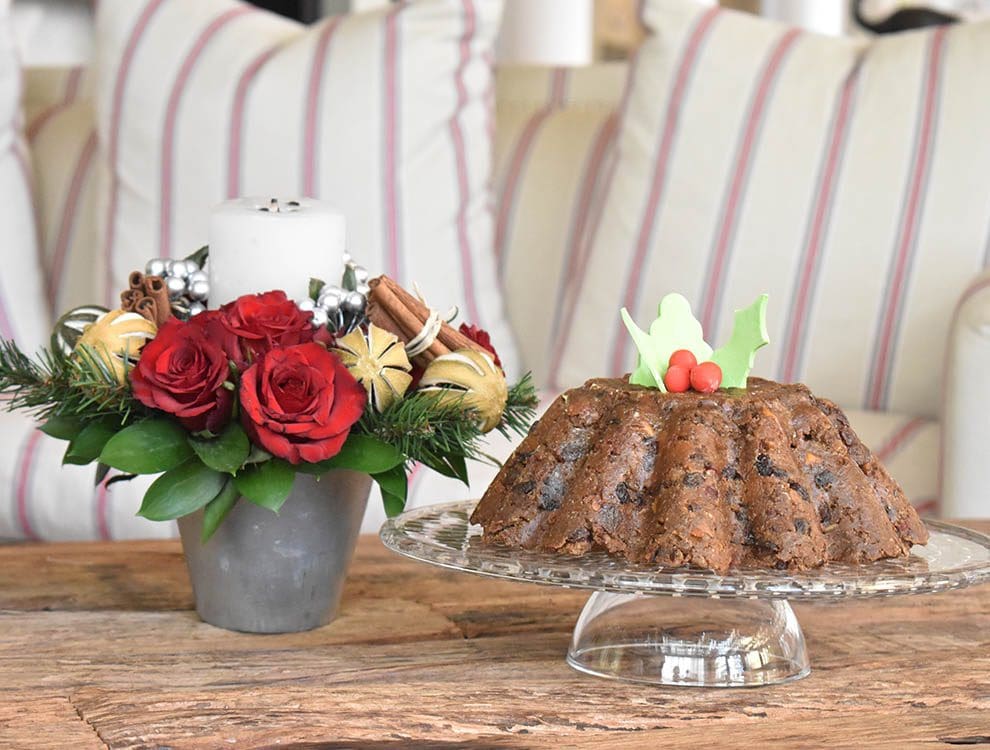
Ingredients (serves 10)
- 900g sultanas
- 120g raisins
- 20g apricots, chopped
- 150g green apples, peeled and chopped
- 100g orange peel
- 200ml fresh orange juice
- 40ml sherry
- 40ml brandy
- 40ml rum
- 200g unsalted softened butter
- 240g brown sugar
- 120g eggs
- 240g self-rising flour
- 20g mixed spices
- 80g bread crumbs
- 80g whole almonds
- 50g Suet
Method
- Soak all the dried fruit with orange peel in orange juice, sherry, rum and brandy for at least 1 week.
- Cream the butter with brown sugar until fluffy, add in the eggs.
- Sift together the self-rising flour and mixed spices, fold into the creamed mixture with bread crumbs and nuts. Add suet to bind the pudding.
- Pour the mixture into the mould and bake with combi-steam at 160 degrees for 1 hour.
Rabanadas with Cinnamon Crème Brûlée, Orange Ice Cream & Port Wine Reduction from Quinta Da Comporta – Portugal

For the French toast (serves 4)
- 500g traditional Brioche
- 240ml whole milk
- 3 eggs
- 1 cinnamon stick
- 1 lemon peel
- 100g granulated white sugar
- 1 teaspoon cinnamon powder
- 250ml oil for frying
- Trim the brioche, cut into cubes and set aside.
- In a saucepan, add the milk, cinnamon stick, lemon peel and 15g of sugar, boil and let it rest.
- Beat the eggs in a bowl and set aside.
- In another bowl, mix the remaining 85g of sugar with the cinnamon powder.
- Preheat oil in a pan. Soak the brioche cubes in the prepared milk, then in the egg mixture and fry in the pan. Once the bread is golden brown, take it out of the pan and place on paper to remove any excess oil.
- Finally, dip the brioche in the cinnamon sugar, making sure to coat each side evenly.
For the Crème Brûlée
- 250ml semi-skimmed milk
- 2 egg yolks
- 20g granulated white sugar
- 6g cornstarch flour
- 1 cinnamon stick
- 1 lemon peel
- Blowtorch (to burn the cream)
- Put the milk in a saucepan, add the cinnamon stick and the two lemon rinds. Bring to a boil and remove from heat. Then remove the cinnamon stick and lemon.
- Beat the egg yolks with sugar and cornflour until the the mixture doubles in size, then slowly add the milk, stirring constantly until it is very smooth.
- Put the mixture back in the pan and bring to medium heat, stirring constantly until it thickens.
- Place in the container to be served and let it cool (a container that can withstand the temperature as we are going to caramelise the sugar).
- Pour the sugar over the cream and burn it with the blowtorch.
For the orange ice cream
- Zest of 4 medium oranges
- 2 sheets of gelatin
- 120g condensed milk
- 20ml orange liqueur
- 200ml cream
- Orange food colouring (for a more intense orange colour)
- With the help of a vegetable peeler, carefully peel off large pieces of the orange part of the skin only (avoiding the white pith). Juice the same oranges and set aside.
- Hydrate the gelatin sheets in cold water for about 30 seconds.
- Place the condensed milk and the gelatin leaves in a pan and heat until the gelatin leaves melt – remove from the heat and let it cool.
- While the previous preparation is cooling, whip the cream and set aside.
- Add the orange juice, liqueur, and orange zest to the condensed milk preparation and mix well. Then add the whipped cream, finishing with the orange food colouring until you get the desired tone.
- Place in the freezer for a minimum of 6 hours before serving.
For the Port reduction
- 250ml Port wine
Place the Port wine in a pot and simmer until it reduces to about ¼ of the original amount and set aside. Decorate the dish with orange zest, cinnamon sticks, star anises, and rosemary.
Eggnog Pannacotta from Culloden Estate & Spa – Northern Ireland
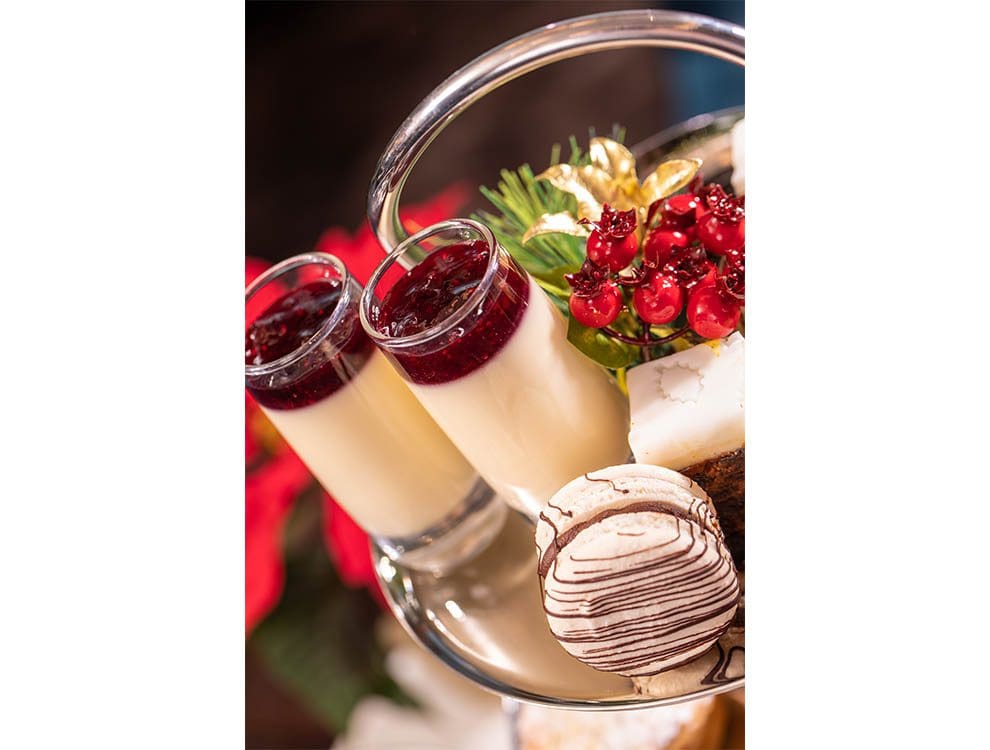
For the pannacotta
- 1L double cream
- 300ml white rum
- 150g caster sugar
- 2 cinnamon sticks
- Fresh nutmeg
- 6 gelatine leaves
Put everything apart from the nutmeg into a pot and bring to the boil, soften the gelatine in cold water then add to the mixture. Pour into cups or glasses and set in the fridge.
For the mulled wine jelly
- 300ml red wine
- 3 cloves
- 1 cinnamon stick
- 300ml cranberry juice
- 50g sugar
- 6 gelatine leaves
Soften the gelatine in cold water, bring the rest to the boil then add gelatine to the wine mixture. When the pannacotta is firm, pour a little of the cooled wine mixture on top to make a layer of jelly. Make sure the wine mix isn’t too hot or it will melt the cream mix.
Panettone from The VIEW Lugano – Switzerland
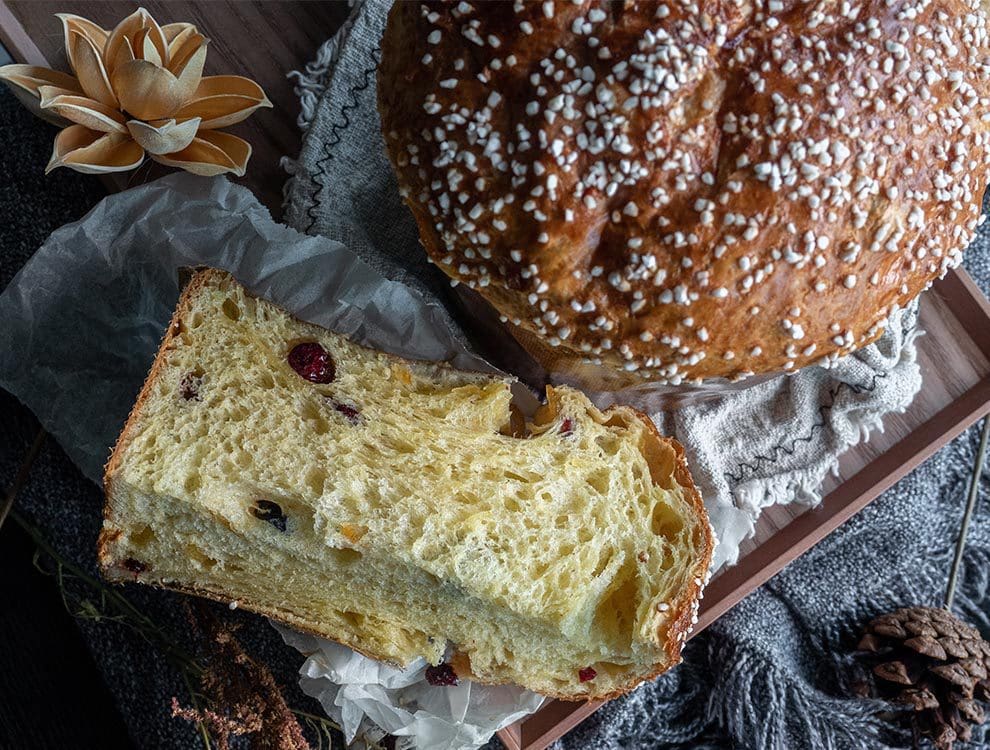
For the first dough
- 125g natural yeast
- 85g sugar
- 60g water
- 215g flour
- 120g yolk
- 20ml water
- 140g butter
For the second dough
- All of the first dough
- 55g flour
- 35g sugar
- 5g salt
- 25g butter
- 30g yolk
- 2 vanilla pods
- 100g rehydrated sultanas
- 180g candied orange
- 60g candied citron
Method
- Start with the first dough using the yeast ready after 3 refreshments – add it to flour, sugar, the first dose of water and all the egg yolks.
- Mix for 15 minutes until you get to a stringy consistency. Add the second serving of water in two splashes and once fully absorbed, combine the soft butter in three batches. As soon as the dough is perfectly strung and smooth, place it in a large bowl for 23 hours at a temperature of 26 degrees.
- After this time, the dough will have tripled in size and you can proceed with the second dough after having left it to rest for at least 30 minutes in the fridge.
- Add the second dose of flour and let it absorb completely (this will take about 15 minutes). After making sure you have achieved a perfect string, combine all the other ingredients together except the candied fruit.
- After 15 minutes, add the candied fruit and wait for them to be distributed evenly inside the dough. Then remove the dough from the mixer, and let it rest for 15 minutes. Always calculate 10% more of the dough than the size of the mold used. Use the Pirlatura method to work the dough, allowing 15 minutes to pass between each other.
- Put the loaves in the molds and leave to prove for at least 8 hours covered with film at a temperature of 30 degrees. When it reaches 2cm from the edge, remove the film in order to create a thin crust on the surface, cut the dough, insert a few knobs of butter into the cut and bake in a static oven at 165 degrees for approximately 55 minutes, until the centre of the loaf reaches 94 degrees.
- Remove from the oven and turn over with the special pins. Allow to cool completely and decorate as you wish.
Bûche de Noël (Yule Log) from Topping Rose House – USA
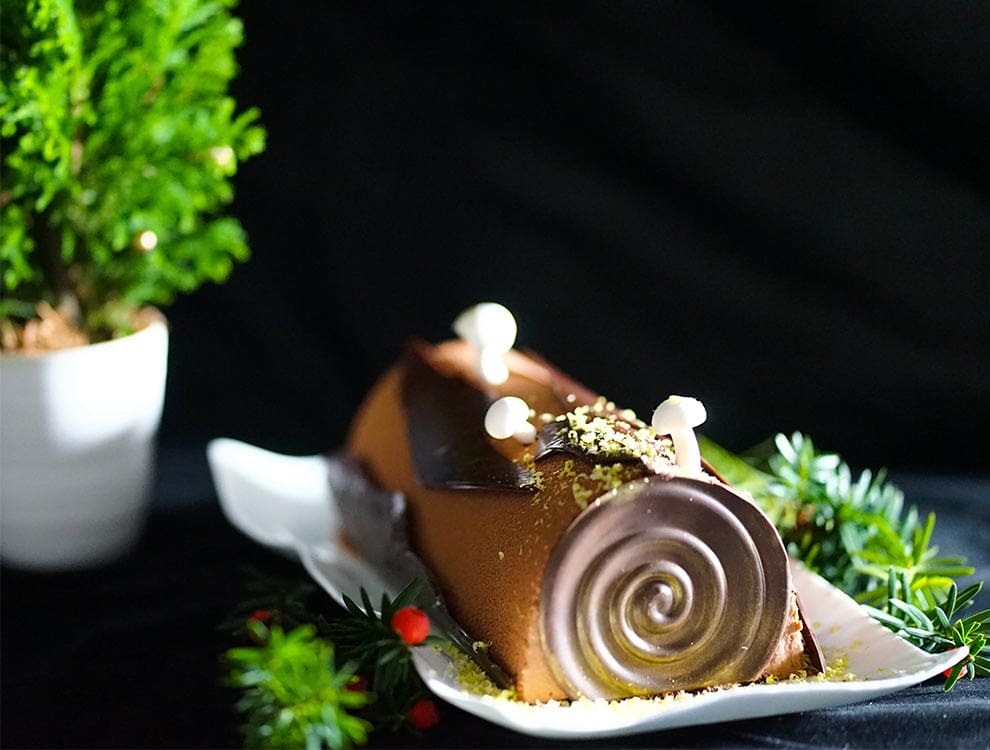
For the cake
- 2 cups sugar
- 1 2/3 cup all-purpose flour
- 1 cup Valrhona cocoa powder
- 1 ½ tsp baking soda
- ½ tsp baking powder
- ½ tsp salt
- 2 eggs
- ½ cup Safflower oil
- 1 cup buttermilk
- 1 cup water
- Preheat oven to 350F. Spray one 10 x 14” ½ sheet tray with nonstick cooking spray. Line the bottom with parchment paper and lightly spray again.
- In a large bowl sift the dry ingredients (sugar, cocoa powder, baking soda, baking powder, salt) together.
- In a separate bowl, mix the wet ingredients (Safflower oil, vanilla extract, buttermilk, and water) together.
- Slowly add the wet ingredients to the dry ingredients while whisking to insure there are no lumps, and the mixture is smooth and well combined.
- Place the cake batter into the pan and allow it to sit at room temperature for 30 minutes.
- Place in the oven and bake until a light touch on the top the cake springs back. Remove and cool. Slice slightly smaller than your bûche mold.
For the dark chocolate mousse
- 4 cups heavy whipping cream
- 11 egg yolks
- ¼ cup agave or corn syrup
- 1 ½ cup sugar
- 3 cups 70% chocolate
- Whip the cream until it slightly thickens and set aside. Melt the chocolate in a bowl on a double boiler.
- Whip the yolks in a KitchenAid. Cook the agave and sugar to 121 degrees and then pour inside of the whipping yolks.
- Whip until cool and then slowly stream the chocolate into the whipping yolks. Fold in the whipped cream. Assemble the log right away.
To assemble
- Fill the mold half way with mousse. Add Sicilian pistachios, diced candied orange zest, and dried cranberries.
- Push the cake down in the mold, forcing the mousse up the sides of the mold. Scrape the bottom and cover with cookie crumble and freeze.
- When frozen, remove from the mold and decorate with meringue mushrooms, chocolate bark, grated pistachios, cocoa powder and some confectioners sugar. Try to have fun with it, get creative, and make it look like a log ready to be thrown on a fire.
No-Bake Rooibos & Amarula Cheesecake with Wit Blitz Cherries from The Plettenberg – South Africa
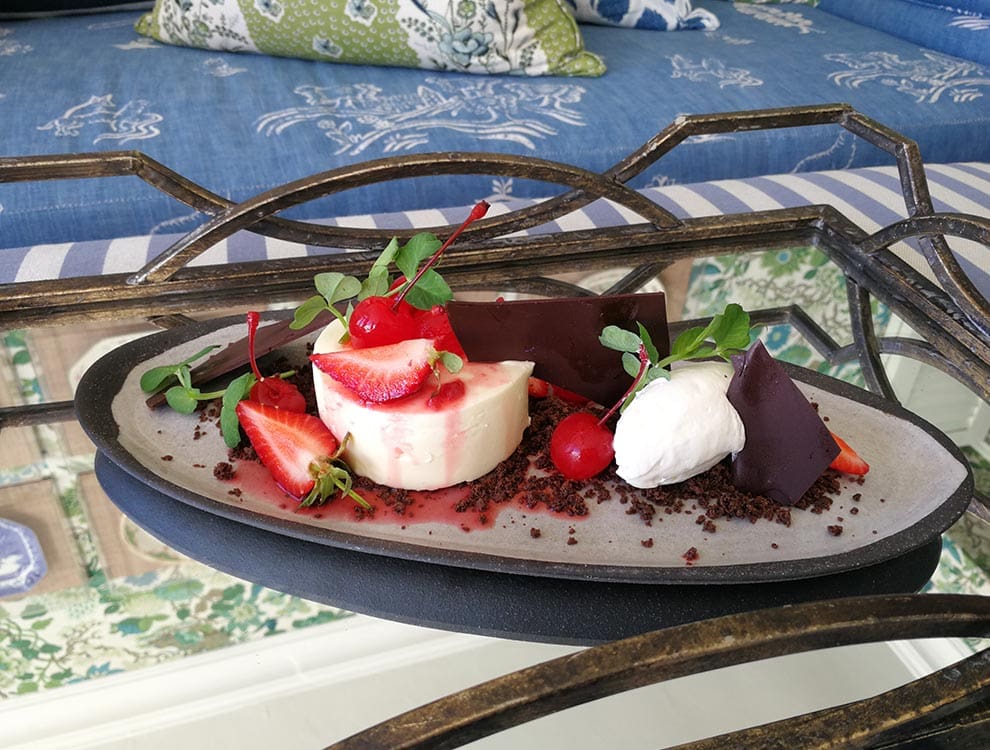
With the South African summer falling over Christmas, a cold dessert is the general go-to in the sweltering heat. Three iconic flavours only found in South Africa are Rooibos tea, Amarula liquor, wit blitz (or “white lightning” is a clear spirit that has been distilled in South Africa for many years. Wit Blitz is predominately produced in the Western Cape over 200 years.) So here is a recipe that contains all three ingredients in one go.
Ingredients
- 7 leaves gelatin or 21g gelatin powder
- 500g smooth cream cheese
- 500ml cream
- 2 rooibos teabags
- 250ml milk
- 250ml amarula cream liquor
- 200g sugar
- 10-15 fresh cherries or maraschino cherries
- 50ml wit blitz
Method
- Begin by blooming the gelatin in some water.
- Take the fresh cherries and slice in half – if using maraschino cherries, keep whole, add the wit blitz to them in a small bowl and set in fridge, stirring them every few hours to allow them to macerate.
- Heat the milk and tea bags together, over a medium heat until the milk starts to simmer. Remove from heat, stir in the bloomed gelatin, and allow to draw for 5 minutes before removing the teabags, and stirring in the amarula. Allow to cool slightly.
- In another saucepan, add 250ml of the cream, the sugar and the cream cheese. Heat gently until the cream cheese has softened and the sugar has dissolved.
- Whisk the last 250ml cream until it forms soft peaks.
- Whisk the cream cheese mixture into the rooibos and amarula mixture. Pass this mix through a strainer to remove any lumps.
- Fold the whipped cream into the strained mixture.
- Pour into lightly greased moulds or a lined cake tin and allow to set for 3-4 hours in the fridge or until firm to the touch before unmoulding and serving topped with the macerated cherries.
Crème Brûlée with Turkish Coffee from Ariana Sustainable Luxury Lodge – Turkey
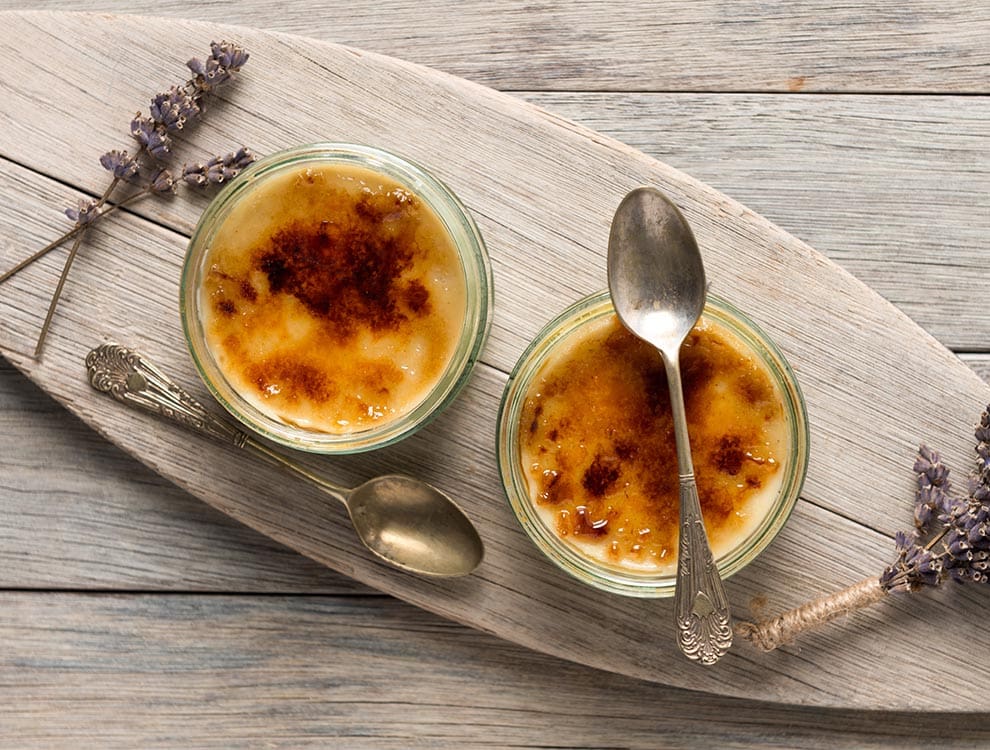
Ingredients
- 2 cups of heavy whipping cream
- 1/3 cup of granulated sugar (or up to 1/2 cup for a sweeter crème brûlée)
- 2 tsp instant Turkish coffee powder
- 1/2 tsp vanilla extract
- 5 large egg yolks
- 1/2 tsp ground cinnamon
- For the topping – 3-4 tbsp granulated sugar (preferably superfine sugar or raw sugar)
Method
- In a saucepan, combine the cream, granulated sugar, and Turkish Coffee powder. Blend well and bring the mixture to a simmer.
- Pour through a fine mesh strainer into a bowl and set aside for about 15 minutes or until it cools to room temperature.
- Heat the oven to 165 degrees. Arrange 6-8 ramekins in a 9 x 13 x 2 inch metal baking pan. If you are using wide shallow ramekins, you might need two pans.
- In a medium bowl, whisk the egg yolks with the cinnamon. Whisk in the cream mixture until well blended.
- Ladle the mixture into the ramekins and fill the outer pan with hot tap water. The water should come about halfway up the sides of the ramekins.
- Bake for 30-40 minutes, depending on the depth of the crème brûlée. Remove the ramekins from the pan—use a spatula and oven mitt—to a rack to cool.
- Cover and refrigerate them for 3-4 hours or until thoroughly chilled. When you are ready to serve, take the ramekins out of the refrigerator.
- Sprinkle 1-2 teaspoons of superfine sugar over each crème brûlée, depending on the surface area of the ramekins. Gently rotate the ramekin, top with fruit and serve with Turkish coffee on the side.
Chocolate Raspberry Cake from The Excelsior – Greece
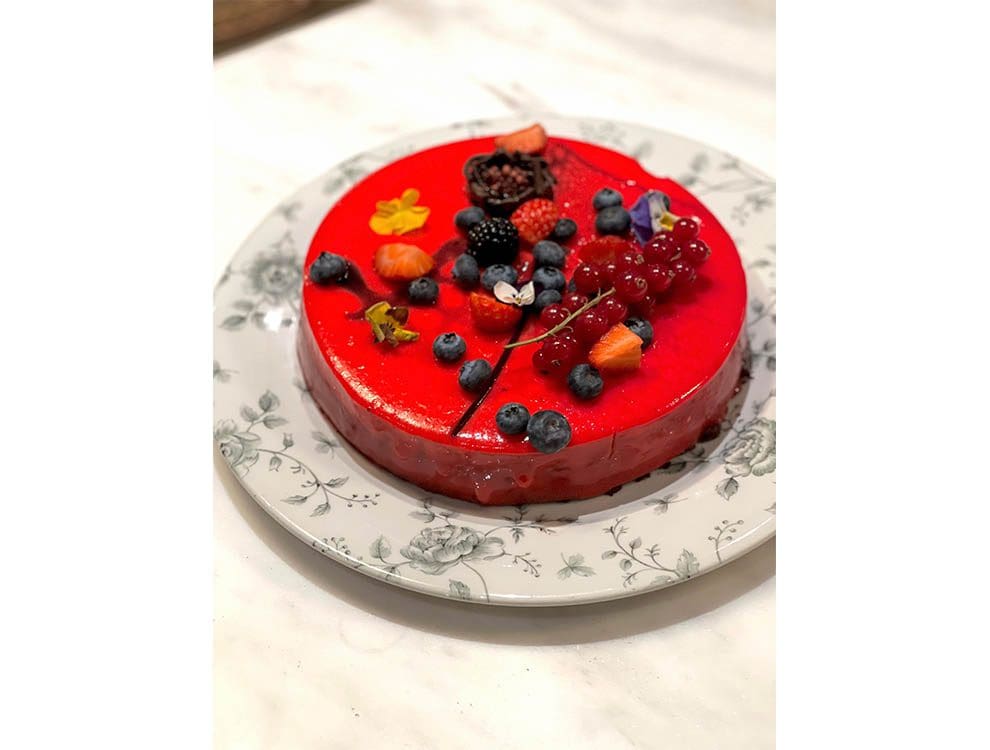
Ingredients
- vegetable oil
- 1 ½ cups all-purpose flour
- ¼ cup cocoa powder
- ¾ teaspoon coarse salt
- 1 ½ sticks unsalted butter, room temperature
- 1 ¼ cups sugar
- 3 large eggs, room temperature
- 1 tablespoon raspberry liqueur, such us Chambord or framboise (optional)
- 1 cup buttermilk, room temperature
- 4 ounces bittersweet chocolate (61% cacao), melted and cooled
For the filling
- 4 packages (6 ounces each) of fresh raspberries
- ¾ cup plus 2 tbsp sugar
- Pinch of coarse salt
- 2 tsp fresh lemon juice
Method
- Preheat the oven to 350 degrees. Lightly coat three 8×2 inch round cake pans with cooking spray. Line bottoms with parchment.
- In a large bowl, whisk together flour, cocoa, baking soda and salt.
- In another large bowl, beat the butter with sugar on a high speed until light and fluffy for 3 minutes. Add the eggs, one at a time, beating well after each addition.
- Beat in the liqueur. Reduce the speed to low and add the flour mixture in three batches, alternating with buttermilk in two batches. Beat to combine, scraping down sides of bowl as needed. Beat in the melted chocolate.
- Divide the butter evenly between the prepared pans, smoothing the tops with an offset spatula.
- Bake for around 25 minutes, rotating pans halfway through front to back and top to bottom, until a tester inserted in the centres comes out clean.
- Let the cakes cool in pans on a wire rack for 10 minutes. Run a small sharp knife around the edges, then invert onto the rack. Remove parchment and let cool completely, about 25 minutes. With a serrated knife, trim tops of cakes so they’re level.
- While the cakes are baking, stir together 3 cups of raspberries, sugar, salt and lemon juice in a medium saucepan. Cook over a high heat for 2 minutes, stirring frequently and mashing with the back of a spoon, until the mixture comes to a boil.
- Continue to cook for 7-8 minutes more, stirring until the mixture thickens and clings to the spoon.
- Let cool for 30 minutes. Stir in 2 cups of raspberries, reserving the remainder.
- Spread half of the filling over one cake. Top with the second layer, and spread the remaining filling over the top.
- Top with the final layer, cut-side down. Refrigerate, covered, for at least 1 hour and up to overnight.
- Spread frosting over the top and sides of the cake. Garnish with the remaining raspberries.
Rabanada de Natal from Pousada Palácio de Estoi – Portugal
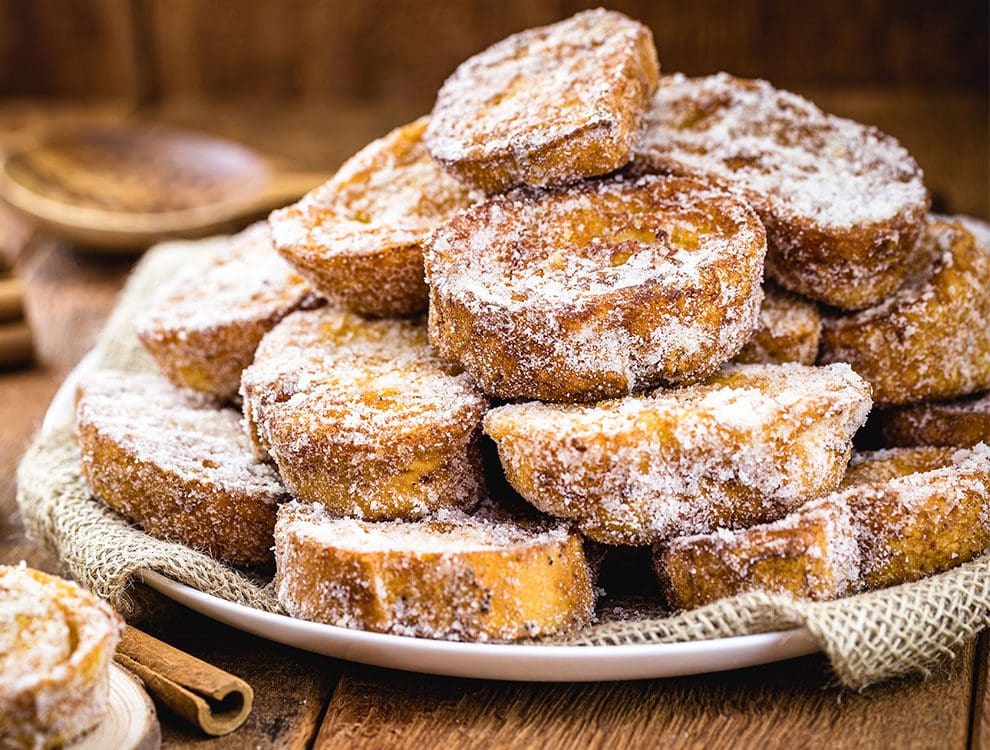
For the French toast
- 500ml oil
- 1 loaf of eve honey bread (12 slices)
- 20ml port wine
- 1L milk
- 2 cinnamon sticks
- 2 tbsp honey
- 150g sugar
- 12 eggs
For the sauce
- 150g sugar
- 2 tbsp honey
- 50ml port wine
- 1 orange (peel and juice)
- 1 lemon (peel and juice)
- 50g pine nuts
- 50g raisins
- 50g walnuts
Method
- Soak the bread in the mixture of milk, cinnamon, honey and sugar and set aside.
- To make the sauce, boil the sugar with a little water, port wine, honey, grated fruit and juices. When it boils, add the dried fruits and set aside.
- In a frying pan, put the oil to boil, dip the bread in the beaten egg and fry.
- Dip the bread in the sugar and cinnamon and drizzle with a dry fruit sauce.
- Serve with a vanilla ice cream ball and decorate with edible flowers.
Monte Bianco VERO from Ca’ di Dio – Italy
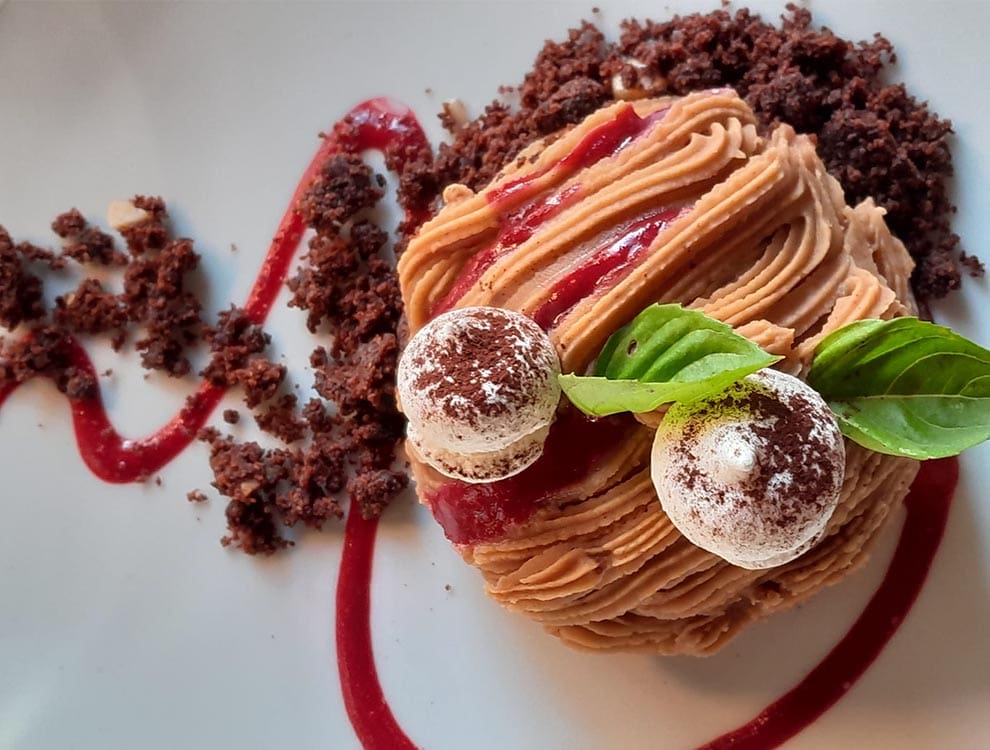
For the Bavarian with chestnuts
- 50g sugar
- 250g milk
- 180g white chocolate
- 100g yolk
- 350g chestnut purée
- 10g gelatin
- 800g whipped cream (glossy)
Cook the milk with sugar and yolk at 85 degrees. Add the warm white chocolate mixture and then the jelly and chestnut purée. Once cooled down, add the shiny whipped cream.
For the Chantilly with classic zabaglione
- 100g milk
- 120g marsala
- 120g yolk
- 180g sugar
- 10g rice starch
Cook all the ingredients together for the pastry cream and then use this base to make a Chantilly cream using 80g of the base plus 350g of whipped cream.
For the chestnut spaghetti
- 400g chestnut purée
- 150g sugar
- 100g butter
Use a 2cm radius disc of sponge cake and wet it with mandarin juice to use as the base of the cake. Top it with Bavarian chestnut sauce and spatulate the Bavarian cream with the zabaglione Chantilly so that the chestnut spaghetti made with the tip from the sac à poche can properly adhere. Finish the dessert with raspberry purée and meringues.
Sweet Treats
Oatmeal Coconut Cookies from Ariana Sustainable Luxury Lodge – Turkey
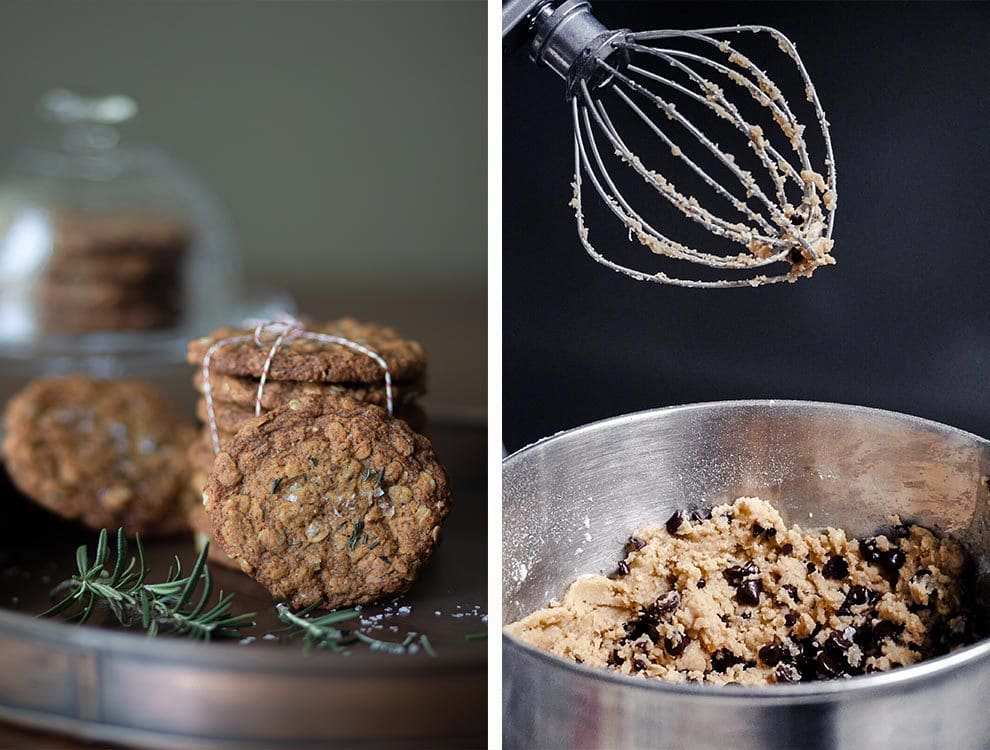
Ingredients
- 200g butter
- 200g powdered sugar
- 200g Muscovado sugar
- 2 eggs
- 400g plain flour
- 60g desiccated coconut
- 100g porridge
- 2 tsp of baking powder
- 1 glass of skimmed milk
Method
- Preheat the oven to 180 degrees. Cream butter and both sugars until smooth.
- Add the egg and whisk until well combined.
- Add all the dry ingredients and mix well until you have a firm dough and the flour is fully incorporated.
- Add the milk and a little bit of dough – stir gently to loosen.
- Use a teaspoon to place golf ball-sized lumps on a greased or lined cookie sheet. Use the back of the spoon to flatten the dough.
- Bake in the oven at 180 degrees for 13-15 minutes or until golden brown and slightly crispy around the edges.
- Remove from the oven and allow to cool on the cookie sheets for 2 minutes and then place on the cooling rack until completely cooled.
Cappadocia Flakes from Ariana Sustainable Luxury Lodge – Turkey
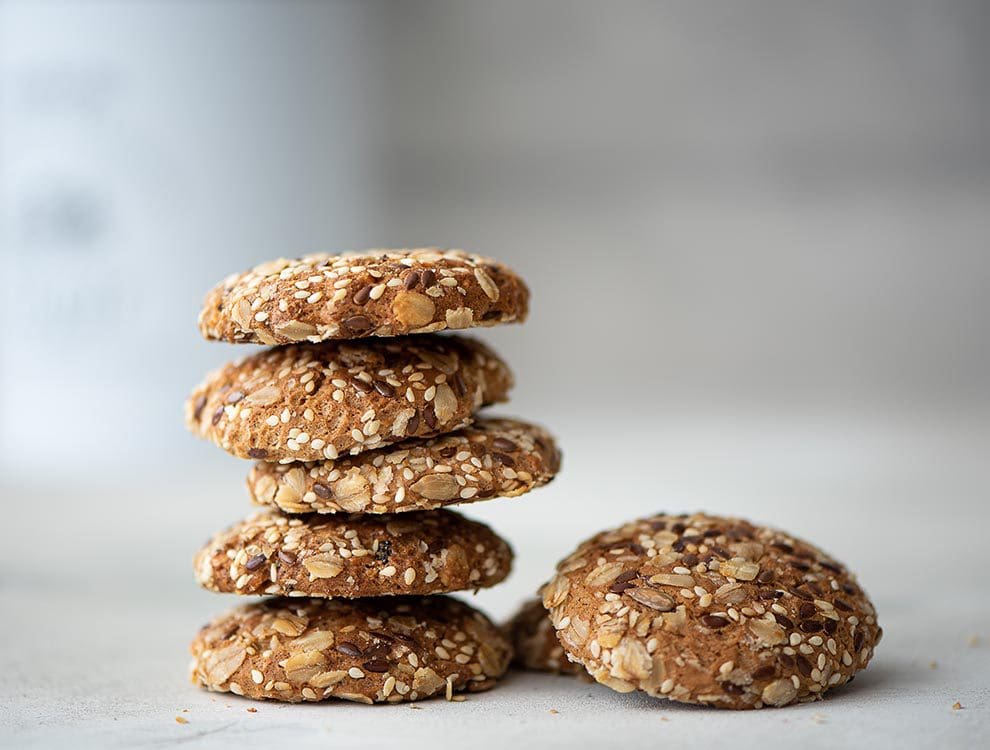
Ingredients
- 200g melted butter
- 75ml oil
- 100ml tahini
- 100ml water
- 350g sugar
- 1 tsp of baking powder
- 1 tsp of vanilla
- 450g flour
- 150ml molasses
- 150ml water
- 200g sesame
Method
- Add all the ingredients except the molasses and sesame and knead the dough, before letting it rest for a little while.
- Roll the dough out 1-2cm thick between 2 greaseproof papers, cut into cookie sized circles then dip in the molasses water mixture and cover it with sesame seeds.
- Bake at 150 degrees until golden brown.
Melomakarona from Columbia Beach Resort – Cyprus
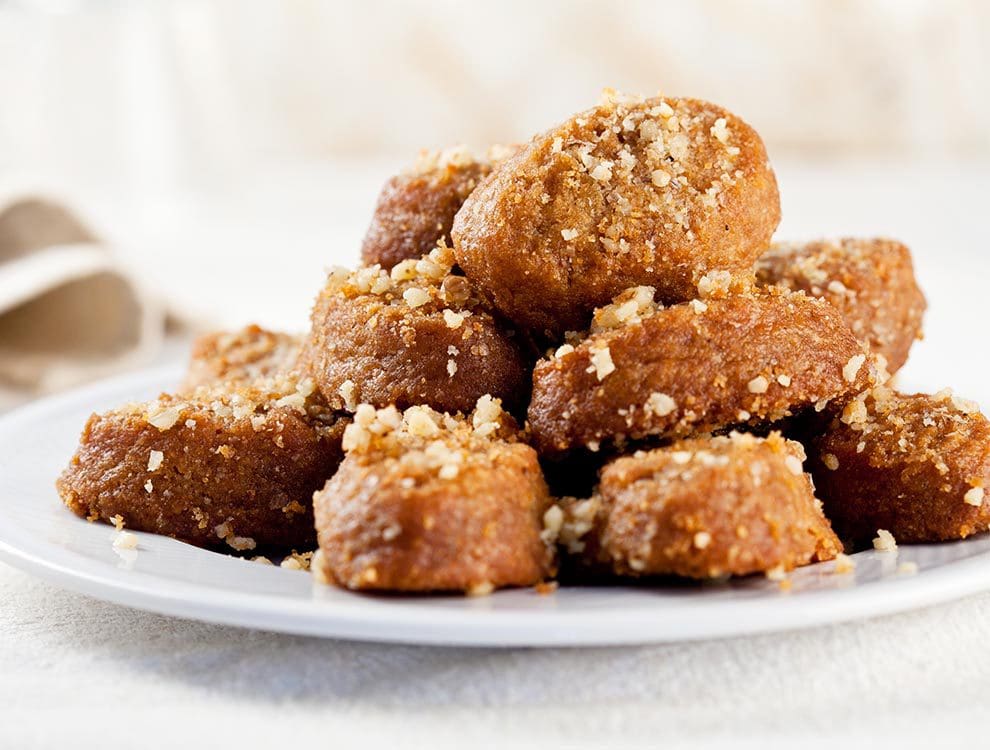
The best melomakarona (deriving from the Greek words for honey and macaronia biscuits) are crispy on the outside, moistly honeyed on the inside and sprinkled with plenty of walnuts, cinnamon and clove spice. As the scent of minced pies and gingerbread baking in British households evoke the spirit of Christmas, so do melomakarana in Greek and Cypriot households.
Ingredients
- 250g olive oil
- 250g corn oil
- 125g orange soft drink
- 1 tsp orange zest
- 1/2 tsp cinnamon powder
- 1/2 tsp clove powder
- 1 tsp baking soda
- 2 tsp baking powder
- 50g brandy
- 250g sugar
- 1kg flour
For the syrup
- 500g honey
- 125g sugar
- 125g water
To garnish
- 250g walnuts
Method
- Bring the syrup ingredients to boil and then allow to cool.
- Mix all of the melomakarona ingredients together until they are combined very well.
- Divide the mixture, making small oval shapes and place them on a greaseproof paper covered baking tray.
- Bake for 20 minutes at 160 degrees.
- While the melomakarona are still hot, dip them into the syrup for 1 minute, using tongs.
- Finally, garnish them with the crushed walnuts.
Madeira Molasses Cookies from Quinta da Casa Branca – Madeira

Ingredients
- 1kg flour
- 500g sugar
- 270g honey molasses
- 125g margarine
- 125g lard
- 10g cinnamon powder
- 5g ground cloves
- 1 ground nutmeg
- 10g milled anise
- 20g baking soda
- 4 eggs
- 1 lemon, zested
Method
- Add all the solid ingredients into a bowl, then place the margarine, lard and eggs in the middle.
- Knead and start to add the rest of the ingredients until the dough becomes well combined (you don’t need to knead too much).
- Make small balls of dough and place on a greased tray.
- Bake in a medium oven between 180-200 degrees until golden brown.
Pettole from Canne Bianche Lifestyle Hotel – Italy
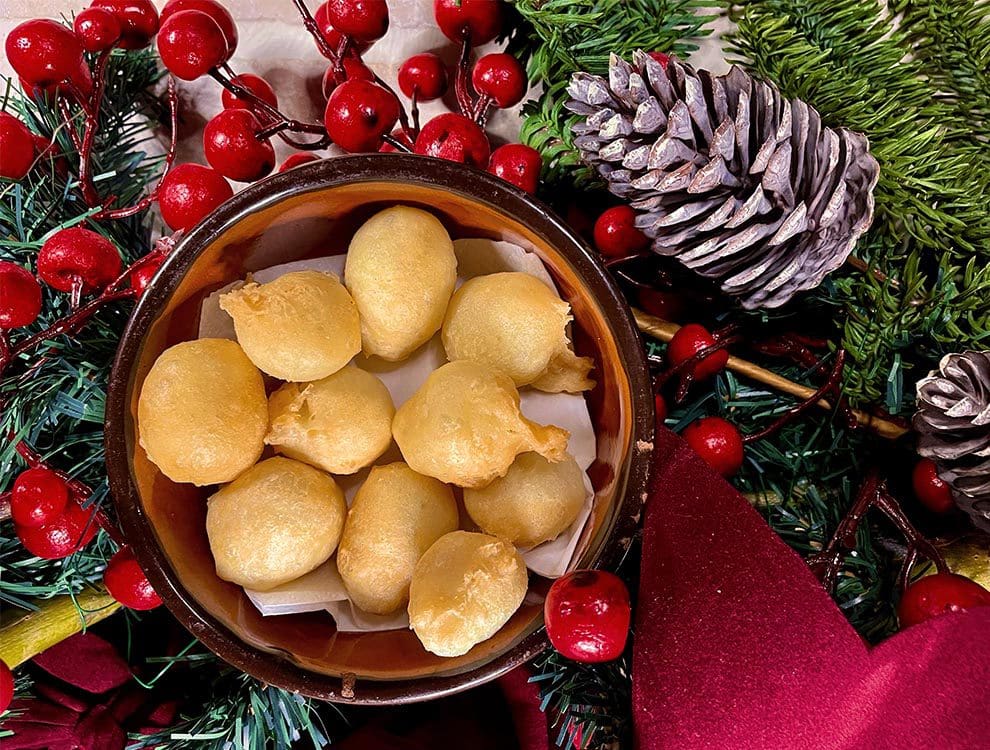
In Puglia, it doesn’t feel like Christmas until you eat pettole – these are small balls of soft raised dough which are deep fried and eaten hot. You can eat them plain for a savoury taste and pair them with vincotto (a thick wine based syrup), grapes or cooked figs or simply with sugar or honey if you prefer a sweeter version. Little ones will like them topped with hazelnut and cocoa spreads too!
Ingredients
- 500g all-purpose flour
- 100g boiled potatoes
- 50ml olive oil
- 12g brewer’s yeast
- Water
- 1 tsp salt
- Olive oil or sunflower seed oil to fry
Method
- Mash your boiled potatoes and place them in a large bowl with flour, salt and olive oil. Knead until the mixture is even.
- Melt yeast in some mild water and add it to the mixture.
- Knead everything together until the mixture looks even and elastic/sticky. Add as much water as needed.
- Cover the dough with a cloth and place it far from chill wind currents. Allow it to raise for 1.5 hours when the dough will double up in size.
- Pour oil in a pan and bring it to high temperature.
- Place your bowl with the raised dough, add some oil and “break” the raise of the dough.
- Using two dinner spoons, and making sure you dip them in a glass of oil so that the dough can easily slip in the pan, take a spoonful of the dough and carefully drop it into the oil by pushing it with the back of the other spoon. Work in batches.
- Another fun, fast and dramatic way to make pettole is to keep one hand constantly in the dough and squeeze the dough through the index finger and the thumb. Collect it with an oiled spoon and drop it in the oil.
- Fry the pettole until golden and puffy. Remove and drain on paper towels. Best served immediately for maximum crunch.
Share this article
Latest stories

Hotel Norman, Paris: design-led luxury steps from the Champs-Élysées
There’s no shortage of glamorous hideaways in Paris, but few manage to bottle an era quite like Hotel Norman. Steps from the Champs-Élysées, this newcomer channels the seductive polish of midcentury modernism with the confidence of a hotel that knows exactly who it’s for: travellers who appreciate quiet luxury, meticulous

6 eco-friendly hotels offering ethical wildlife experiences
If you prefer your wildlife encounters without the crowds — and with a side of serious sustainability — SLH’s Considerate Collection has you covered. And with World Wildlife Conservation Day shining a light on the importance of protecting our planet’s most vulnerable species and habitats, there’s no better moment to

From vineyard valleys to hot springs: top boutique hotels for December
Across continents and climates, location leads the experience at these boutique escapes. A monastery where the cloisters still set the pace, a mountain retreat content to drift with the clouds, a Swiss villa that practically levitates above an alpine lake — each hotel lets its setting do the talking. Here’s

How to spend a weekend in Girona
This pocket-sized city couldn’t be more different to its same-coast cousin, Barcelona. Comfortingly walkable and distinctly Catalan, what Girona lacks in size is made up for with its abundant food scene, ochre-infused colour palette and surrounding mountain landscapes.

